Evaluation of VoIP QoS Performance in Wireless Mesh Networks
Abstract
:1. Introduction
- We integrate and experiment 802.11g/n with 802.11s/e IEEE standards together with G.711 and G.729 voice codecs using AODV and HWMP routing protocols in order to extensively evaluate how VoIP service performs, which can help us to make informed choices about standards, codecs and protocols in WMN implementations. To the best of our knowledge, research dealing with the combination of these standards, codecs, and protocols in the specific type of scenarios considered in this work has not been reported before.
- We investigate the performance of VoIP deployment in five main scenarios (three scenarios with mobility and two scenarios with no mobility). We evaluate how the mobility models (e.g., waypoint mobility and random waypoint mobility) and different area sizes can affect the VoIP performance. For evaluating how the integration of standards and protocols can affect the VoIP performance, we further define six sub-scenarios for each main scenario and experiment with changing standards and protocols.
- Finally, by conducting experiments and extensively evaluating the VoIP performance based on above mentioned points, our research findings show that IEEE 802.11g without being integrated with IEEE 802.11s standard using G.711 and G.729 voice codecs, along with the AODV routing protocol, results in better VoIP performance as compared to the integration of IEEE 802.11g with IEEE 802.11s using the HWMP routing protocol. Similarly, the integration of 802.11n standard using G.711 and G.729 voice codecs, along with the AODV routing protocol, shows poor VoIP performance as compared to the other scenarios. In general, our results show that scenarios with IEEE 802.11g using AODV routing protocol show better VoIP performance as compared to scenarios with IEEE 802.11n using the same routing protocol.
2. VoIP Application and Scenarios
2.1. VoIP Application in WMNs
2.2. VoIP Implementation Scenarios
2.2.1. Emergency Relief Deployment
First Responders
Earthquake/Flooding/Cyclones/Fires
2.3. Urban and Rural Deployment
2.4. Military Operations Deployment
3. Experimental Setup
Configuration Parameters
4. Results and Analysis
4.1. First Responders with Waypoint Mobility
4.2. First Responders with Random Mobility
4.3. Flooded Village
4.4. Isolated Village
4.5. Platoon
4.6. Analysis Summary
- PL4 = Platoon, waypoint mobility, 802.11g, G.729 codec, AODV
- FV2 = Flooded village, no mobility, 802.11g, 802.11, G.711, AODV
- PL2 = Platoon, waypoint mobility, 802.11g, 802.11, G.711, AODV
- FV4 = Flooded village, no mobility, 802.11g, 802.11, G.729, AODV
- FV3 = Flooded village, no mobility, 802.11g, 802.11s, G.729, HWMP
- FR2 = First responders, waypoint mobility, 802.11g, 802.11, G.711, AODV
- FV4 = Flooded village, no mobility, 802.11g, 802.11, G.729, AODV
- FR4 = First responders, waypoint mobility, 802.11g, 802.11, G.729, AODV
- FRW4 = First responders, random waypoint mobility, 802.11g, 802.11, G.729, AODV
- PL4 = Platoon, waypoint mobility, 802.11g, , 802.11, G.729 codec, AODV
- IV5 = Isolated village, no mobility, 802.11n, G.711 codec, AODV
- IV6 = Isolated village, no mobility, 802.11n, G.729 codec, AODV
- IV1 = Isolated village, no mobility, 802.11g, 802.11s, G.711 codec, HWMP
- IV2 = Isolated village, no mobility, 802.11g, 802.11, G.729 codec, AODV
- PL6 = Platoon, waypoint mobility, 802.11n, G.729 codec, AODV
- IV6 = Isolated village, no mobility, 802.11n, G.729 codec, AODV
- IV5 = Isolated village, no mobility, 802.11n, G.711 codec, AODV
- PL3 = Platoon, waypoint mobility, 802.11g, 802.11s, G.729 codec, HWMP
- IV1 = Isolated village, no mobility, 802.11g, 802.11s, G.711 codec, HWMP
- FR3 = First responders, waypoint mobility, 802.11g, 802.11s, G.729, HWMP
- FV3 = Flooded village, no mobility, 802.11g, 802.11s, G.729, HWMP
- IV2 = Isolated village, no mobility, 802.11g, 802.11, G.729 codec, AODV
- PL6 = Platoon, waypoint mobility, 802.11n, G.729 codec, AODV
- PL1 = Platoon, waypoint mobility, 802.11g, 802.11s, G.711 codec, HWMP
- FV5 = Flooded village, no mobility, 802.11n, G.711 codec, AODV
- Integrating the IEEE 802.11g, 802.11s standards with both voice codecs decreases the VoIP performance in scenarios with waypoint mobility and no mobility;
- Integrating the IEEE 802.11n with both voice codecs decreases the VoIP performance in scenarios where the nodes are distant from each other.
- PL4 = Platoon, waypoint mobility, 802.11g, G.729 codec, AODV
- FV2 = Flooded village, no mobility, 802.11g, 802.11, G.711, AODV
- FV4 = Flooded village, no mobility, 802.11g, 802.11, G.729, AODV
- PL2 = Platoon, waypoint mobility, 802.11g, 802.11, G.711, AODV
- FR2 = First responders, waypoint mobility, 802.11g, 802.11, G.711, AODV
- FR4 = First responders, waypoint mobility, 802.11g, 802.11, G.729, AODV
- FRW4 = First responders, random waypoint mobility, 802.11g, 802.11, G.729, AODV
- IV6 = Isolated village, no mobility, 802.11n, G.729 codec, AODV
- IV5 = Isolated village, no mobility, 802.11n, G.711 codec, AODV
- IV1 = Isolated village, no mobility, 802.11g, 802.11s, G.711 codec, HWMP
- PL3 = Platoon, waypoint mobility, 802.11g, 802.11s, G.729 codec, HWMP
- FR3 = First responders, waypoint mobility, 802.11g, 802.11s, G.729, HWMP
- FV3 = Flooded village, no mobility, 802.11g, 802.11s, G.729, HWMP
- IV2 = Isolated village, no mobility, 802.11g, 802.11, G.729 codec, AODV
5. Conclusions
Acknowledgments
Author Contributions
Conflicts of Interest
References
- IEEE Standards Association. IEEE Std 802.11s-2011; IEEE: Piscataway, NJ, USA, 2011. [Google Scholar]
- IEEE Standards Association. IEEE Draft Recommended Practice for Routing Packets in 802.15.4 Dynamically Changing Wireless Networks; P802 15 10/D10 2017; IEEE: Piscataway, NJ, USA, 2007; pp. 1–150. [Google Scholar]
- IEEE Standards Association. IEEE Standard for Local and Metropolitan Area Networks Part 16: Air Interface for Broadband Wireless Access Systems Amendment 1: Multihop Relay Specification; IEEE Std 802 16j-2009 (Amendment to IEEE Std 802 16-2009); IEEE: Piscataway, NJ, USA, 2009; pp. 1–290. [Google Scholar]
- Li, J.; Li, Z.; Mohapatra, P. Adaptive Per Hop Differentiation for End-to-End Delay Assurance in Multihop Wireless Networks. Ad Hoc Netw. J. 2008, 7, 1169–1182. [Google Scholar] [CrossRef]
- Zhang, X.; Li, H.; Zhao, J.; Xing, M.; Li, X. Research on Network Technology of Emergency Communication Based on Ad Hoc Network. J. Appl. Sci. Eng. Innov. 2016, 3, 213–216. [Google Scholar]
- Di Felice, M.; Trotta, A.; Bedogni, L.; Chowdhury, K.R.; Bononi, L. Self-organizing aerial mesh networks for emergency communication. In Proceedings of the IEEE 25th Annual International Symposium on Personal, Indoor, and Mobile Radio Communication (PIMRC), Washington, DC, USA, 2–5 September 2014; pp. 1631–1636. [Google Scholar]
- Paul, A.B.; Chakraborty, S.; De, S.; Nandi, S.; Biswas, S. Adaptive path selection for high throughput Heterogeneous Wireless Mesh Networks. In Proceedings of the IEEE International Conference on Advanced Networks and Telecommuncations Systems (ANTS), Kolkata, India, 15–18 December 2015; pp. 1–6. [Google Scholar]
- Shinko, I.; Oda, T.; Barolli, A.; Kolici, V.; Barolli, L.; Xhafa, F. Performance Analysis of WMNs by WMN-GA Simulation System for Exponential Distribution Considering EDCA and DCF. In Proceedings of the 19th International Conference on Network-Based Information Systems (NBiS), Ostrava, Czech Republic, 7–9 September 2016; pp. 15–21. [Google Scholar]
- Sheikh, S.M.; Wolhuter, R.; van Rooyen, G.J. Performance and comparative analysis of design schemes for prioritised data in multi-hop Wireless Mesh backbone networks. In Proceedings of the 12th International Joint Conference on e-Business and Telecommunications (ICETE), Colmar, France, 20–22 July 2015; pp. 13–23. [Google Scholar]
- Basarkod, P.I.; Manvi, S.S. Mobility and QoS aware anycast routing in Mobile ad hoc Networks. Comput. Electr. Eng. 2015, 48, 86–99. [Google Scholar] [CrossRef]
- Haibeh, L.A.; Hakem, N.; Safia, O.A. Performance evaluation of VoIP calls over MANET for different voice codecs. In Proceedings of the IEEE 7th Annual Computing and Communication Workshop and Conference (CCWC), Las Vegas, NV, USA, 9–11 January 2017; pp. 1–6. [Google Scholar]
- Singh, H.P; Singh, S.; Singh, J.; Khan, S.A. VoIP: State of art for global connectivity—A critical review. J. Netw. Comput. Appl. 2014, 37, 365–379. [Google Scholar] [CrossRef]
- Meeran, M.T.; Tucker, W.D. An analysis of voice over Internet Protocol in wireless mesh networks. In Proceedings of the 4th International Conference on Wireless Communications, Vehicular Technology, Information Theory and Aerospace & Electronic Systems (VITAE), Aalborg, Denmark, 11–14 May 2014; pp. 1–5. [Google Scholar]
- Alam, M.M.; Hamida, E.B. Performance Evaluation of IEEE 802.15.6-based WBANs under Co-Channel Interference (To appear). Int. J. Sens. Netw. 2016, 1. [Google Scholar] [CrossRef]
- Owczarek, P.; Zwierzykowski, P. Review of Simulators for Wireless Mesh Networks. J. Telecommun. Inf. Technol. 2014, 3, 82–89. [Google Scholar]
- SCALABLE Network Technologies, Inc. Network Technologies QualNet 7.4 User’s Guide; SCALABLE Network Technologies, Inc.: Culver City, CA, USA, 2015. [Google Scholar]
- ITU-T. P.800.2 Mean Opinion Score Interpretation and Reporting; ITU-T: Geneva, Switzerland, 2013. [Google Scholar]
- Chakraborty, T.; Misra, I.S.; Sanyal, S.K. QoS Enhancement Techniques for Efficient VoIP Performance in Cognitive Radio Network. Int. J. Comput. Inf. Syst. Ind. Manag. Appl. 2014, 6, 413. [Google Scholar]
- Nguyen-Duc, T.; Kamioka, E. An SDN Approach for an Energy Efficient Heterogeneous Communication Network in Disaster Scenarios. Int. J. Wirel. Mob. Netw. 2016, 8, 1. [Google Scholar] [CrossRef]
- Conrad, J.M.; Randall, M.E.; Vaughn, G.; Shadwell, P.F.; Randall, G.W. Development and deployment of the IEEE MOVE emergency relief vehicle. In Proceedings of the IEEE Global Humanitarian Technology Conference (GHTC), Washington, DC, USA, 13–16 October 2016; pp. 255–260. [Google Scholar]
- Navarro, L.; Baig, R.; Freitag, F.; Dimogerontakis, E.; Tréguer, F.; Dulong de Rosnay, M.; Maccari, L.; Micholia, P.; Antoniadis, P. Network Infrastructure as Commons. Report on Existing Community Networks and Their Organization. 2016. Available online: http://netcommons.eu/sites/default/files/netcommons_brochure.pdf (accessed on 20 July 2017).
- Çalik, O.; Iricioglu, U.; Kurt, G.K.; Pusane, A.E.; Demiroglu, A.S.; Kayik, G. Impact of retransmissions on the quality of experience in VoIP systems. In Proceedings of the National Conference on Electrical, Electronics and Biomedical Engineering (ELECO), Bursa, Turkey, 1–3 December 2016; pp. 617–621. [Google Scholar]
- Gerpott, T.J.; May, S.; Nas, G. The impact of mobile Internet on mobile voice usage: A two-level analysis of mobile communications customers in a GCC country. Inf. Manag. 2017. [Google Scholar] [CrossRef]
- Paganelli, A.; Saladino, D.; Casoni, M. QoS performance evaluation of multimedia services in emergency networks. In Proceedings of the 8th International Wireless Communications and Mobile Computing Conference (IWCMC), Limassol, Cyprus, 27–31 August 2012; pp. 933–938. [Google Scholar]
- ITU-T. G.107 The E-Model: A Computational Model for Use in Transmission Planning; ITU-T: Geneva, Switzerland, 2015. [Google Scholar]
- Ghosh, S. Comparative Study of Various VoIP applications in 802.11a Wireless Network Scenario. Int. J. Mob. Netw. Commun. Telemat. 2013, 3, 29. [Google Scholar] [CrossRef]
- Malik, A.; Qadir, J.; Ahmad, B.; Alvin Yau, K. Ubaid Ullah QoS in IEEE802.11-based wireless networks: A contemporary review. J. Netw. Comput. Appl. 2015, 55, 24. [Google Scholar] [CrossRef]
- Meeran, M.T.; Annus, P.; Le Moullec, Y. The current state of voice over internet protocol in wireless mesh networks. In Proceedings of the International Conference on Advances in Computing, Communications and Informatics (ICACCI), Jaipur, India, 21–24 September 2016; pp. 2567–2575. [Google Scholar]
- Silva Mineiro, E.P.; Muchaluat-Saade, D.C. Admission Control for QoS Provision in Wireless Mesh Networks. In Proceedings of the IEEE Symposium on Computers and Communications (ISCC), Cappadocia, Turkey, 1–4 July 2012; p. 331. [Google Scholar]
- Mysirlidis, C.; Galiotosy, P.; Dagiuklasz, T.; Kotsopoulos, S. Performance quality evaluation with VoIP traffic aggregation in Mobile Ad-Hoc Networks. In Proceedings of the 2013 IEEE 14th International Symposium and Workshops on a World of Wireless, Mobile and Multimedia Networks (WoWMoM 2013), Madrid, Spain, 4–7 June 2013; p. 1. [Google Scholar]
- LAN/MAN Standards Committee. IEEE Std 802.11e-2005; LAN/MAN Standards Committee: Piscataway, NJ, USA, 2005. [Google Scholar]
- Estepa, A.J.; Vozmediano, M.J.; López, J. Impact of VoIP codecs on the Energy Consumption of Portable Devices, PM2HW2N’11. In Proceedings of the 6th ACM Workshop on Performance Monitoring and Measurement of Heterogeneous Wireless and Wired Network, Miami, FL, USA, 31 October–4 November 2011. [Google Scholar]
- Nisar, K.; Amphawan, A.; Hassan, S.; Sarkar, N.I. A comprehensive Survey on scheduler for VoIP over WLAN. Netw. Comput. Appl. 2013, 36, 933. [Google Scholar] [CrossRef]
- Seyedzadegan, M.; Othman, M.; Borhanuddin, M.A.; Shamala, S. Internet Gateway Placement Optimization in Wireless Mesh Networks. In Proceedings of the Internet of Things, Smart Spaces, and Next Generation Networking 13th International Conference, NEW2AN 2013 and 6th Conference, ruSMART 2013, St. Petersburg, Russia, 28–30 Audust 2013; p. 318. [Google Scholar]
- Zeng, F.; Yao, L.; Chen, Z. Delay Variation Optimized Traffic Allocation Based on Network Calculus for Multi-path Routing in Wireless Mesh Networks. Appl. Math. Inf. Sci. Int. J. 2013, 7, 467. [Google Scholar] [CrossRef]
- Appini, N.R.; SubbaRao, C.D.V. QoS Aware Multicast Framework based on WayPoint Routing for Hybrid Wireless Mesh Networks. In Proceedings of the IEEE International Conference on Electrical, Computer and Communication Technologies (ICECCT), Coimbatore, India, 5–7 March 2015. [Google Scholar]
- Sundaramoorthy, K.; Rao Madhane, S.S. The Effect of Secure Routing with QoS Amplification (SRQA) in Wireless Mesh Networks. In Proceedings of the 2nd International Conference on Current Trends in Engineering and Technology (ICCTET), Coimbatore, India, 8 July 2014; p. 484. [Google Scholar]
- Engelhardt, F.; Lindhorst, T.; Nett, E. Tolerating Packet Losses in Wireless Mesh Networks. In Proceedings of the IEEE 27th International Parallel and Distributed Processing Symposium Workshops & PhD Forum (IPDPSW), Cambridge, India, 20–24 May 2013; p. 1470. [Google Scholar]
- Chhabra, A.; Singh, D. Assessment of VoIP E-Model over 802.11 Wireless Mesh Network. In Proceedings of the International Conference on Advances in Computer Engineering and Applications, Ghaziabad, India, 17–19 December 2015; p. 856. [Google Scholar]
- Channa, M.I.; Ahmed, K.M. Emergency Response Communications and Associated Security Challenges. Int. J. Netw. Secur. Appl. 2010, 2, 179. [Google Scholar] [CrossRef]
- Cheng, S.-M.; Huang, W.-R.; Cheng, R.-G.; Gan, C.-H. Experimental emergency communication systems using USRP and GNU radio platform. In Proceedings of the 11th International Conference on Heterogeneous Networking for Quality, Reliability, Security and Robustness (QSHINE), Taipei, Taiwan, 19–20 August 2015; pp. 75–79. [Google Scholar]
- Liberal, F.; Fajardo, J.O.; Lumbreras, C.; Kampichler, W. European NG112 Crossroads: Toward a New Emergency Communications Framework. IEEE Commun. Mag. 2017, 55, 132–138. [Google Scholar] [CrossRef]
- Abusch-Magder, D.; Bosch, P.; Klein, T.E.; Polakos, P.A.; Samuel, L.G.; Viswanathan, H. 911-NOW: A network on wheels for emergency response and disaster recovery operations. Bell Labs Tech. J. 2007, 11, 113–133. [Google Scholar] [CrossRef]
- When Communications Infrastructure Fails during a Disaster. Available online: http://www.drj.com/articles/online-exclusive/when-communications-infrastructure-fails-during-a-disaster.html (accessed on 9 January 2017).
- Hajdarevic, K.; Konjicija, S. A low energy computer infrastructure for radio VOIP supported communication and SDR APRS in education and disaster relief situations. In Proceedings of the 38th International Convention on Information and Communication Technology, Electronics and Microelectronics (MIPRO), Opatija, Croatia, 25–29 May 2015; pp. 556–561. [Google Scholar]
- Panitzek, K.; Schweizer, I.; Bradler, D.; Mühlhäuser, M. City Mesh—Resilient First Responder Communication. In Proceedings of the 8th International ISCRAM, Lisbon, Portugal, 8–11 May 2011; p. 1. [Google Scholar]
- Johnson, R. Unreliable Wireless Network Left First Responders High And Dry during Louisiana Floods. Forbes. 23 August 2016. Available online: https://www.forbes.com/sites/realspin/2016/08/23/unreliable-wireless-network-left-first-responders-high-and-dry-during-louisiana-floods/#55a9ffaa4fb2 (accessed on 20 July 2017).
- Let Them Browse While They Eat Cake. Available online: http://www.economist.com/blogs/babbage/2012/01/municipal-wi-fi (accessed on 14 February 2017).
- Yevsieieva, O.; Al-Azzawi, E.M. Choosing of optimal cluster size in WiMax mesh network under hierarchical cross-layer routing. In Proceedings of the Second International Scientific-Practical Conference Problems of Infocommunications Science and Technology (PIC S & T), Kharkiv, Ukraine, 13–15 October 2015; pp. 29–32. [Google Scholar]
- How to Design Outdoor Wireless Networks for Campus Mobile Classrooms? Available online: http://nhprice.com/category/cisco-networking (accessed on 3 March 2017).
- Loyd, B.D.; Sivakumar, D. A case study on VoIP over WMN based architecture for future e-governance of Indian rural areas. In Proceedings of the IEEE Technological Innovation in ICT for Agriculture and Rural Development (TIAR), Chennal, India, 7–8 April 2015; pp. 66–71. [Google Scholar]
- Kulkarni, R.; Padmanabhan, R.; Sivalingam, K.M.; Jalihal, D.; Giridhar, K. WiMAX Mesh Based Back-Haul for Tactical Military and Disaster Area Networks. In Proceedings of the Fourth International Conference on Communication Systems and Networks (COMSNET), Bangalore, India, 3–7 January 2012; pp. 1–10. [Google Scholar]
- Secure Wi-Fi for the Battlefield. Available online: https://www.thalesgroup.com/en/secure-wifi-battlefield (accessed on 15 June 2017).
- Mobile Mesh Networks for Military, Defense and Public Safety. Available online: http://meshdynamics.com/military-mesh-networks.html (accessed on 15 May 2017).
- Alam, M.M.; Hamida, E.B.; Arbia, D.B.; Maman, M.; Mani, F.; Denis, B.; D’Errico, R. Realistic Simulation for Body Area and Body-To-Body Networks. Sensors 2016, 16, 561. [Google Scholar] [CrossRef] [PubMed]
- MOS Calculation & Aggregation; VOIP Future: Hamburg, Germany, 2015; Available online: https://www.voipfuture.com/wordpress/wp-content/uploads/2015/10/VPF123_WP_MOS-Calculation-And-Aggregation.pdf (accessed on 20 July 2017).
- Anand, K.; Samrat, G.; Samir, R.D.; Suman, B. VoIP on Wireless Meshes: Models, Algorithms and Evaluation. In Proceedings of the 26th IEEE International Conference on Computer Communications (INFOCOM), Anchorage, AK, USA, 6–12 May 2007; pp. 2036–2044. [Google Scholar]
- Andre, T.; Arumugam, P.; Bettstetter, C. Experimental evaluation of multihop-aware cooperative relaying. In Proceedings of the 13th International Symposium on Modeling and Optimization in Mobile, Ad Hoc, and Wireless Networks (WiOpt), Mumbai, India, 25–29 May 2015; pp. 96–101. [Google Scholar]
- Wang, X.; Liu, W.; Yang, L.; Zhang, W.; Peng, C. A new content-centric routing protocol for Vehicular Ad Hoc Networks. In Proceedings of the 22nd Asia-Pacific Conference on Communications (APCC), Yogyakarta, Indonesia, 25–27 August 2016; pp. 552–558. [Google Scholar]
- Sharma, A.; Kumar, R. Performance comparison and detailed study of AODV, DSDV, DSR, TORA and OLSR routing protocols in ad hoc networks. In Proceedings of the Fourth International Conference on Parallel, Distributed and Grid Computing (PDGC), Solan, India, 22–24 December 2016; pp. 732–736. [Google Scholar]
- Ali, T.E.; Khalil al Dulaimi, L.A.; Majeed, Y.E. Review and performance comparison of VANET protocols: AODV, DSR, OLSR, DYMO, DSDV & ZRP. In Proceedings of the Al-Sadeq International Conference on Multidisciplinary in IT and Communication Science and Applications (AIC-MITCSA), Baghdad, Iraq, 9–10 May 2016; pp. 1–6. [Google Scholar]
- Kaur, P.; Kaur, D.; Mahajan, R. A review and comparison of AODV, DSR and ZRP routing protocols on the basis of qualitative metrics. In Proceedings of the 3rd International Conference on Computing for Sustainable Global Development (INDIACom), New Delhi, India, 16–18 March 2016; pp. 3262–3266. [Google Scholar]
- Kim, Y.; Dehkanov, S.; Park, H.; Kim, J.; Kim, C. The Number of Necessary Nodes for Ad Hoc Network Areas. In Proceedings of the 2nd IEEE Asia-Pacific Service Computing Conference (APSCC), Tsukuba, Japan, 11–14 December 2007; pp. 146–150. [Google Scholar]
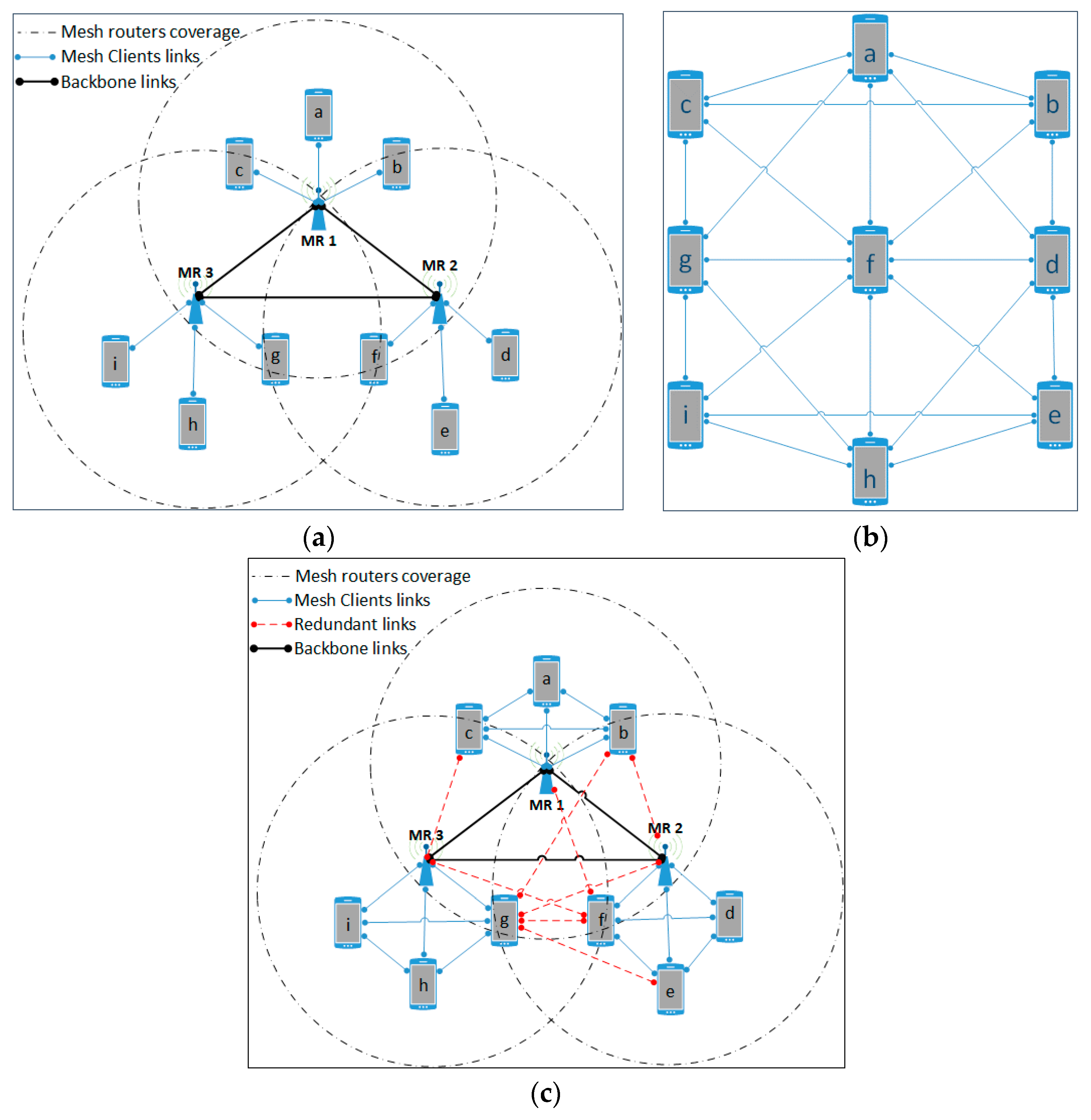
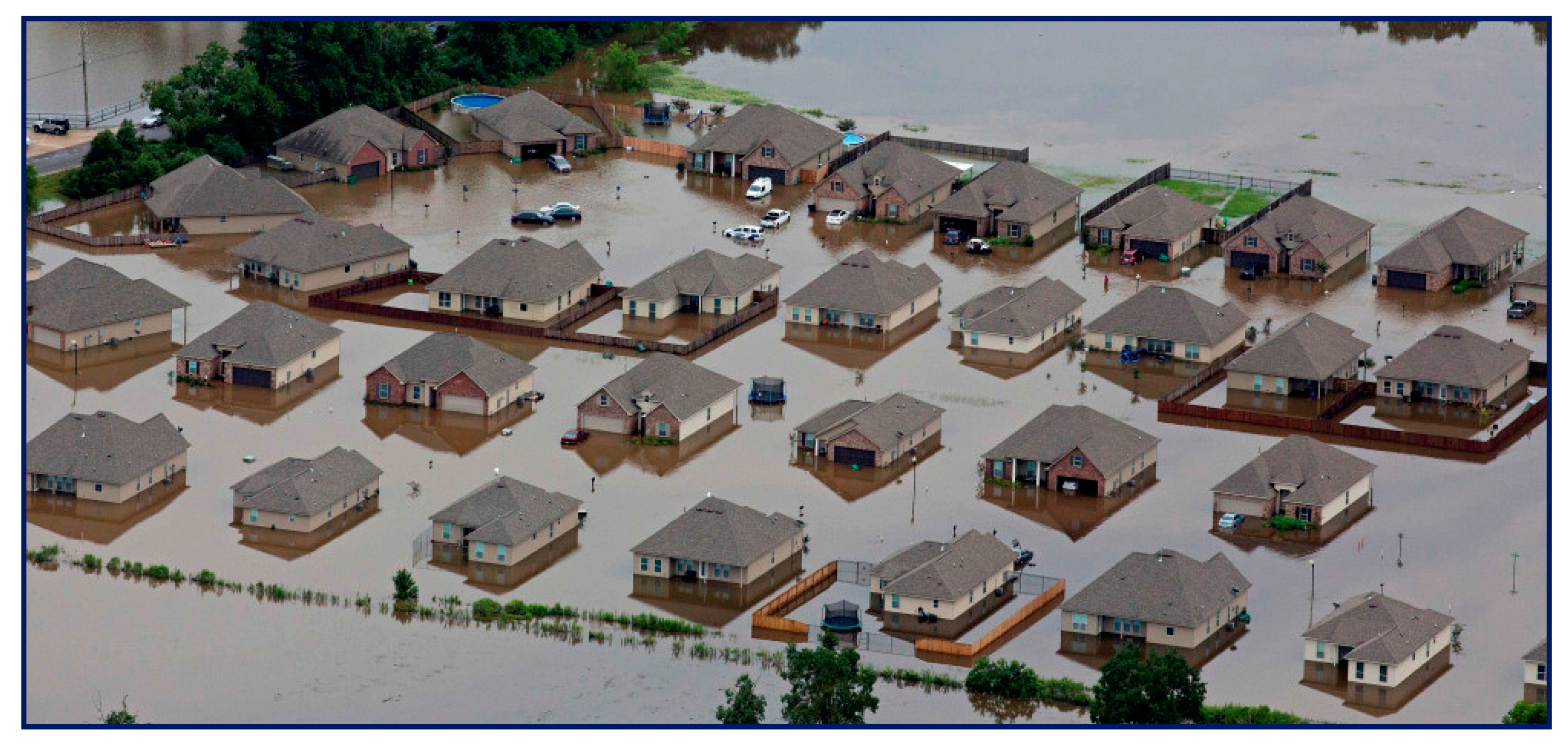
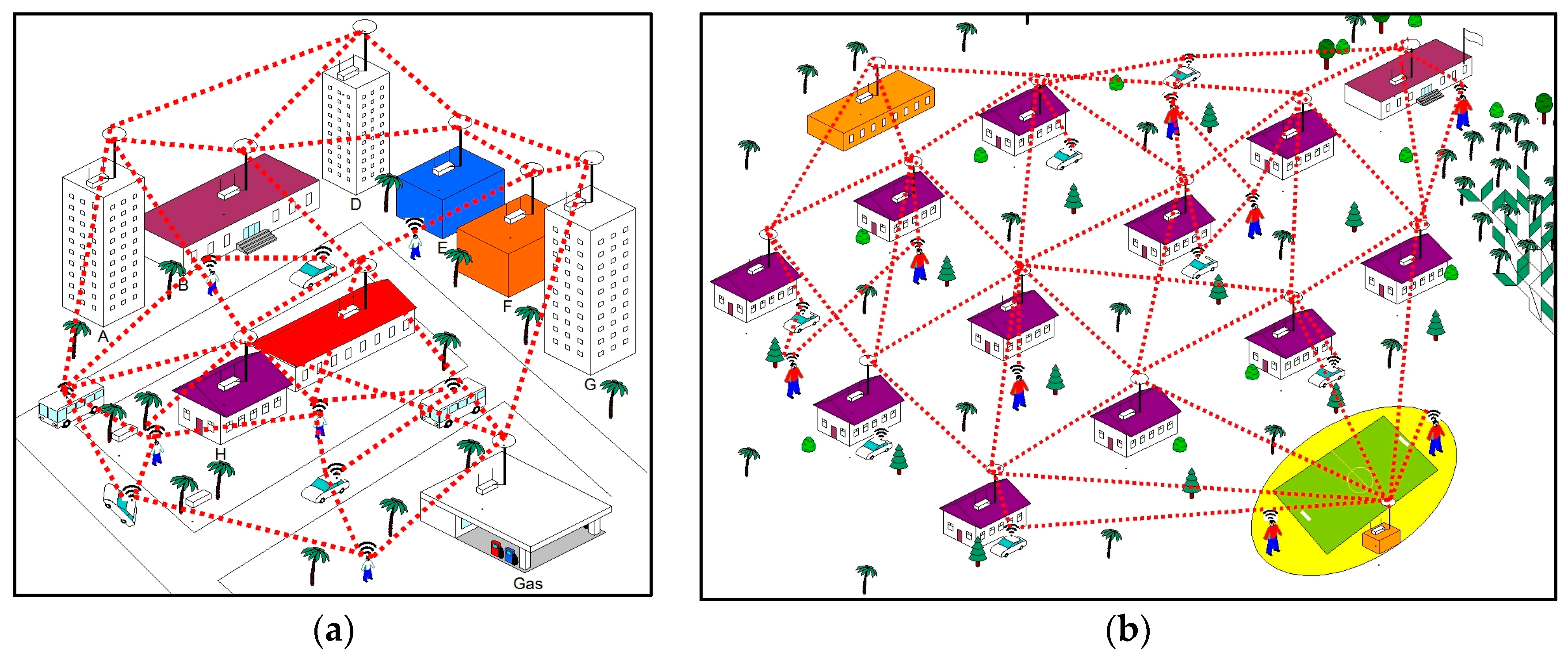
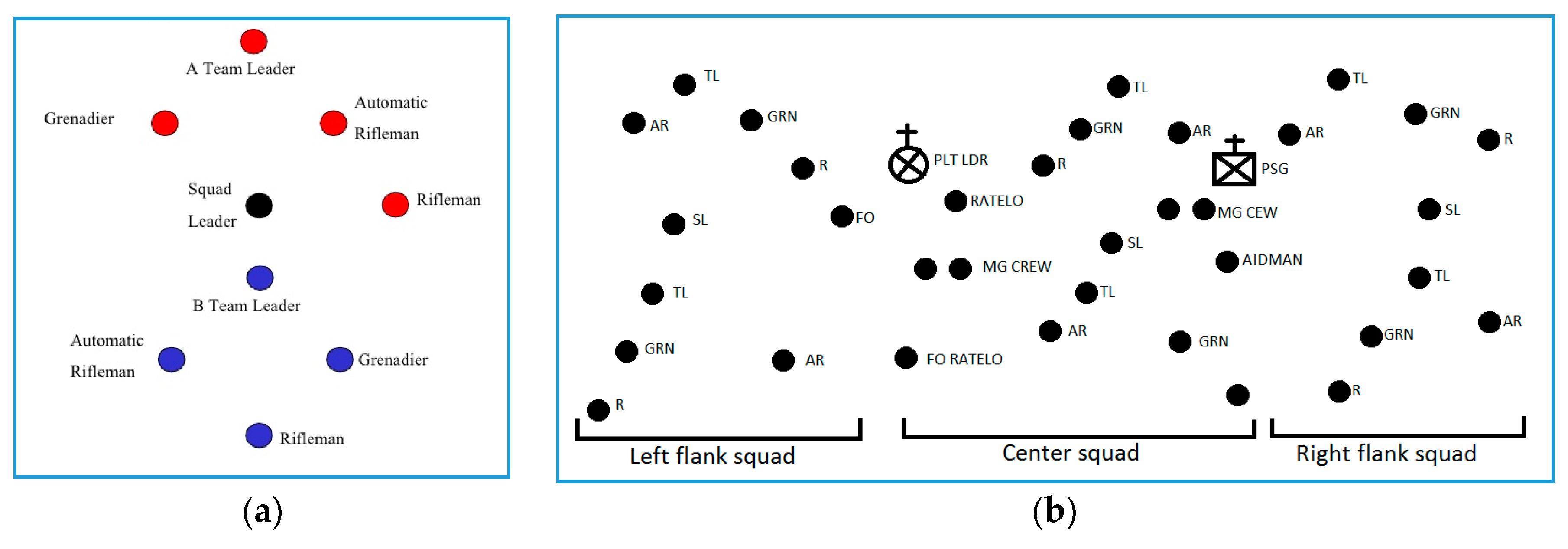
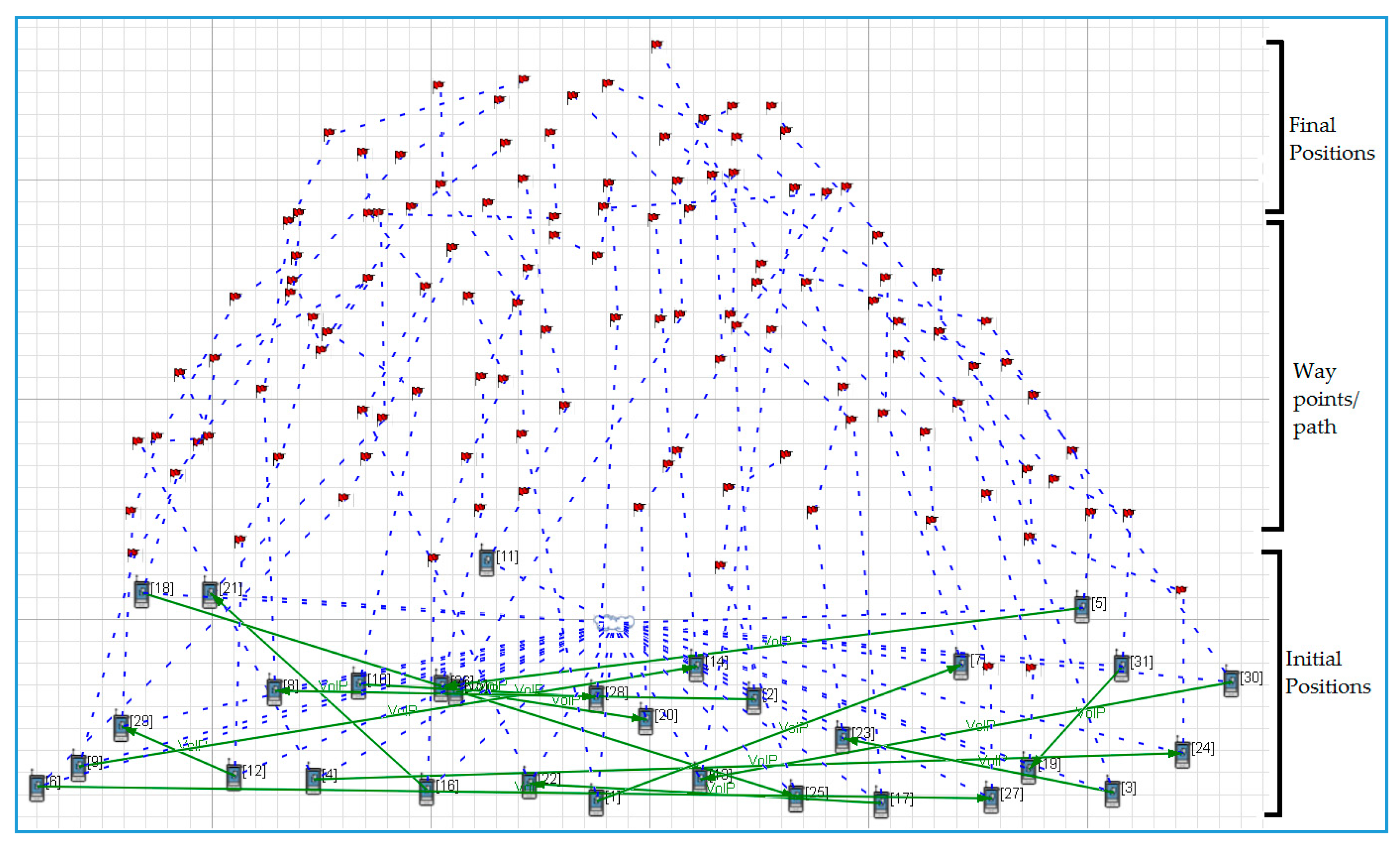
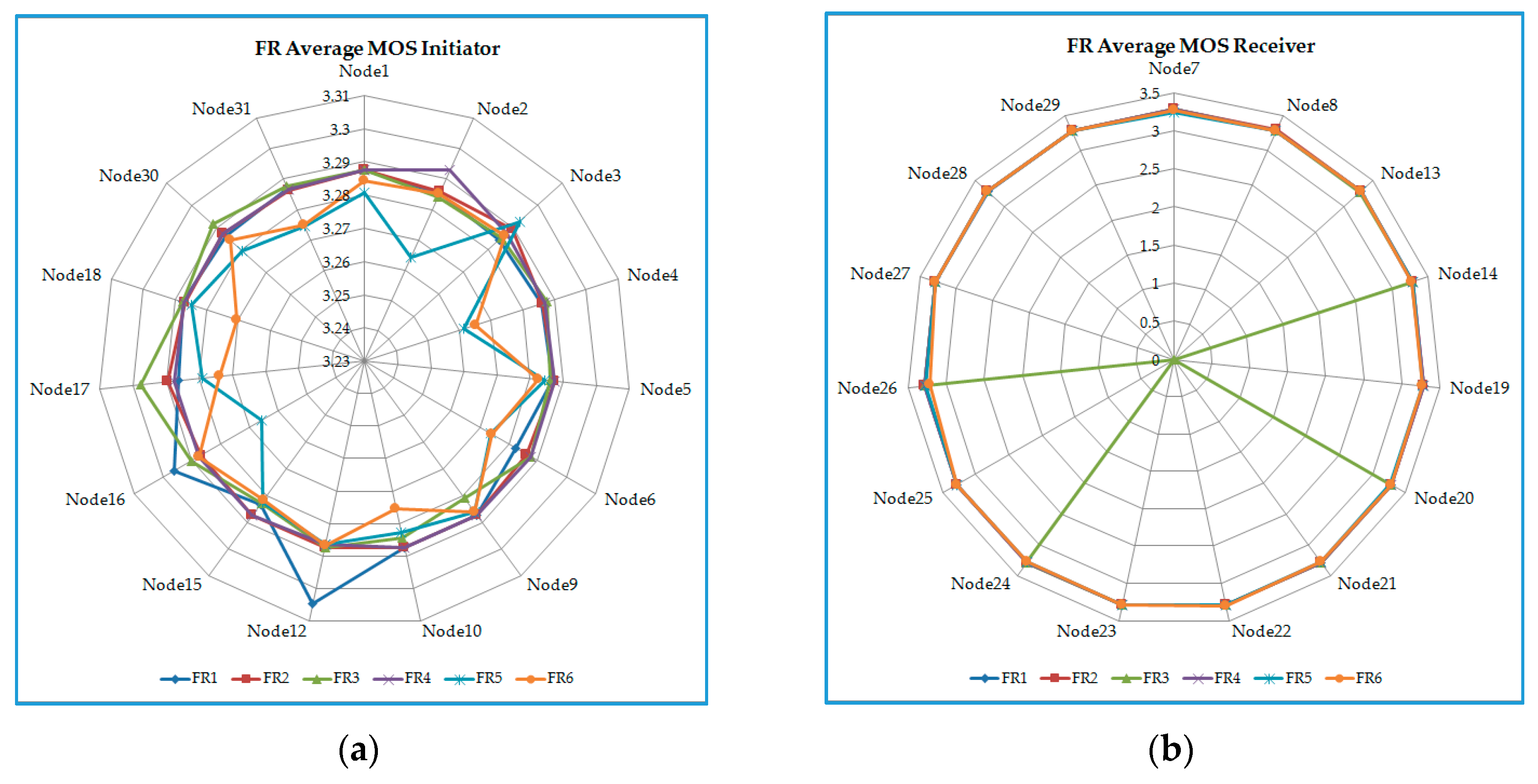
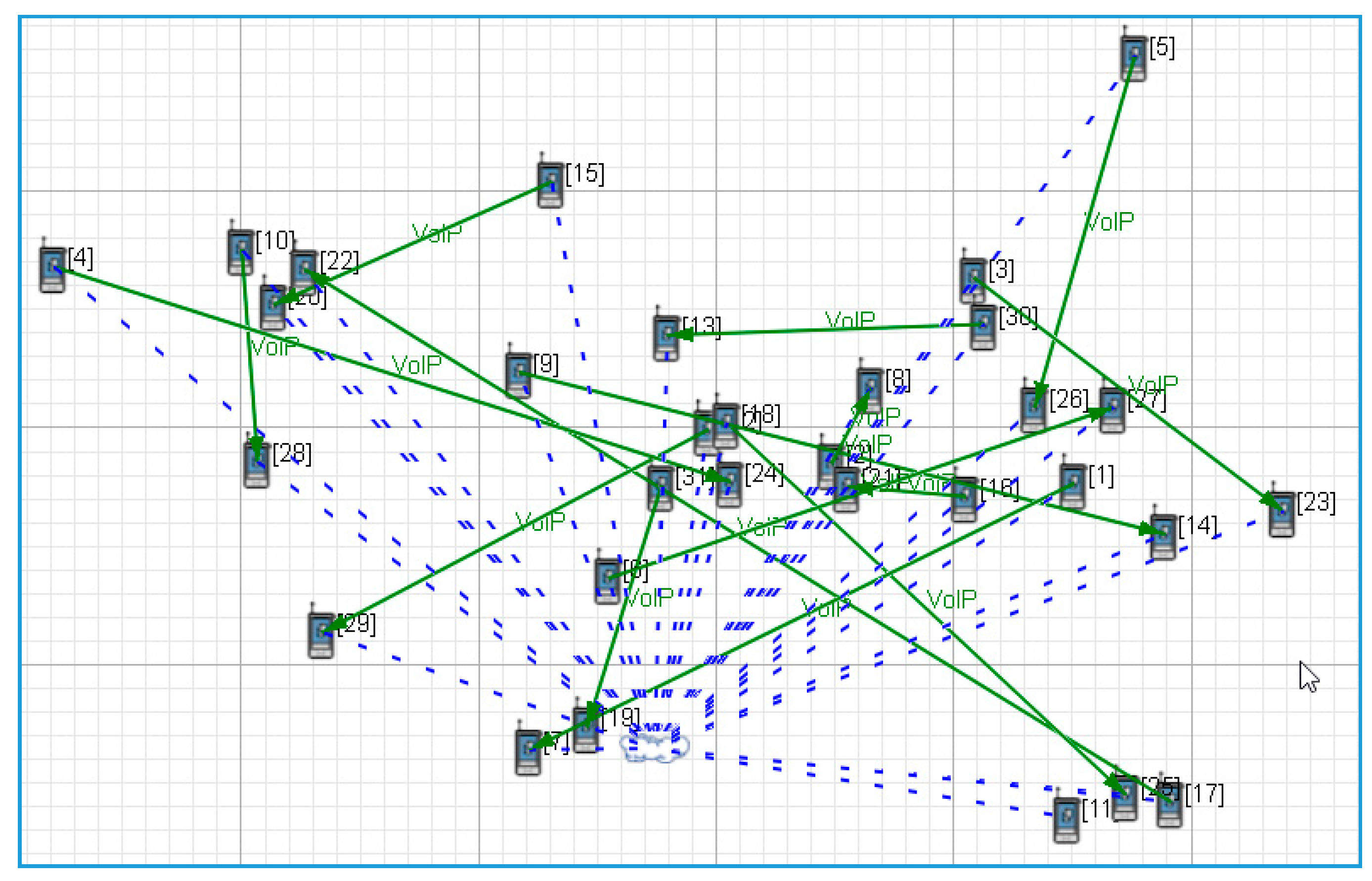
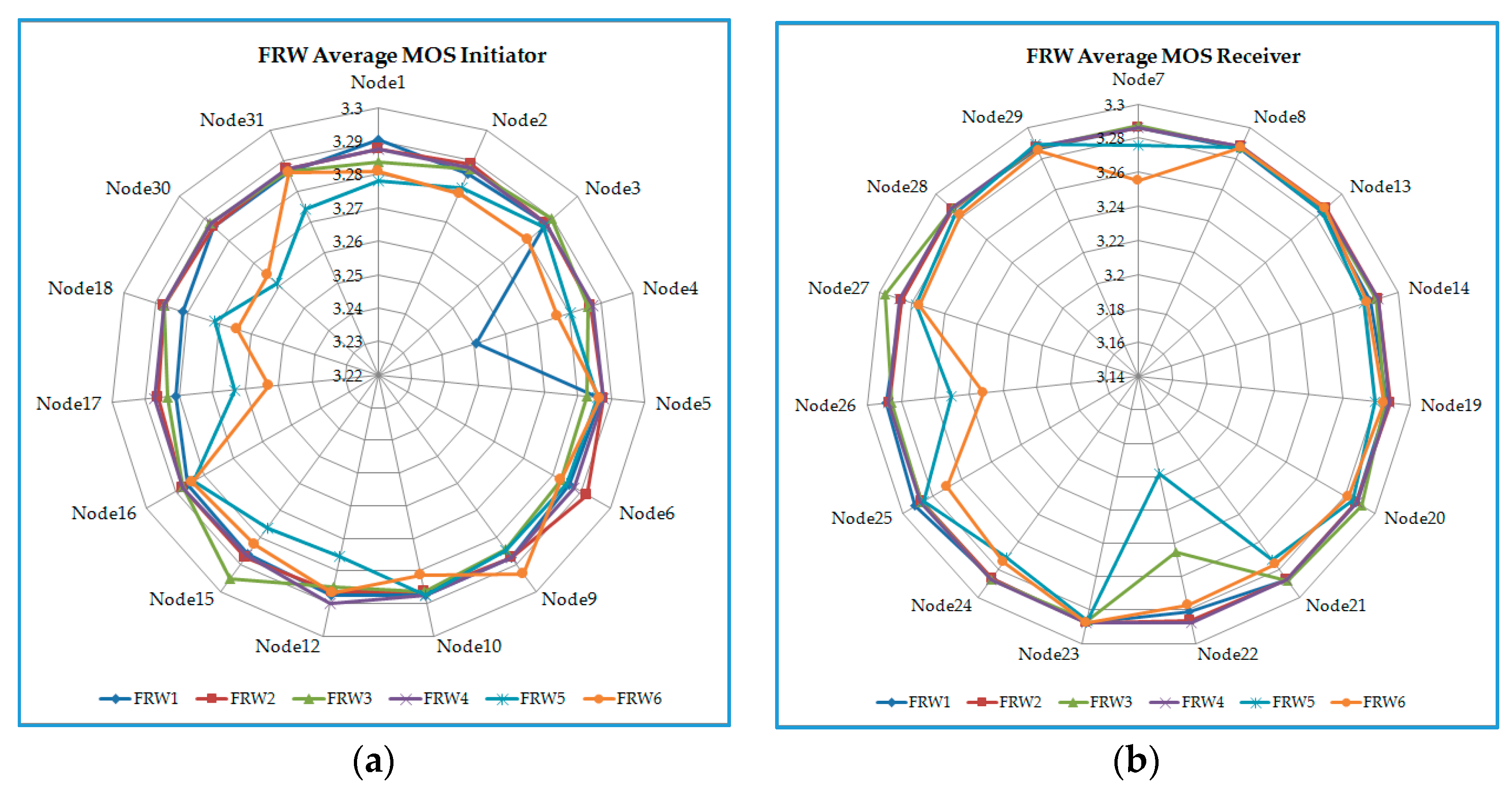
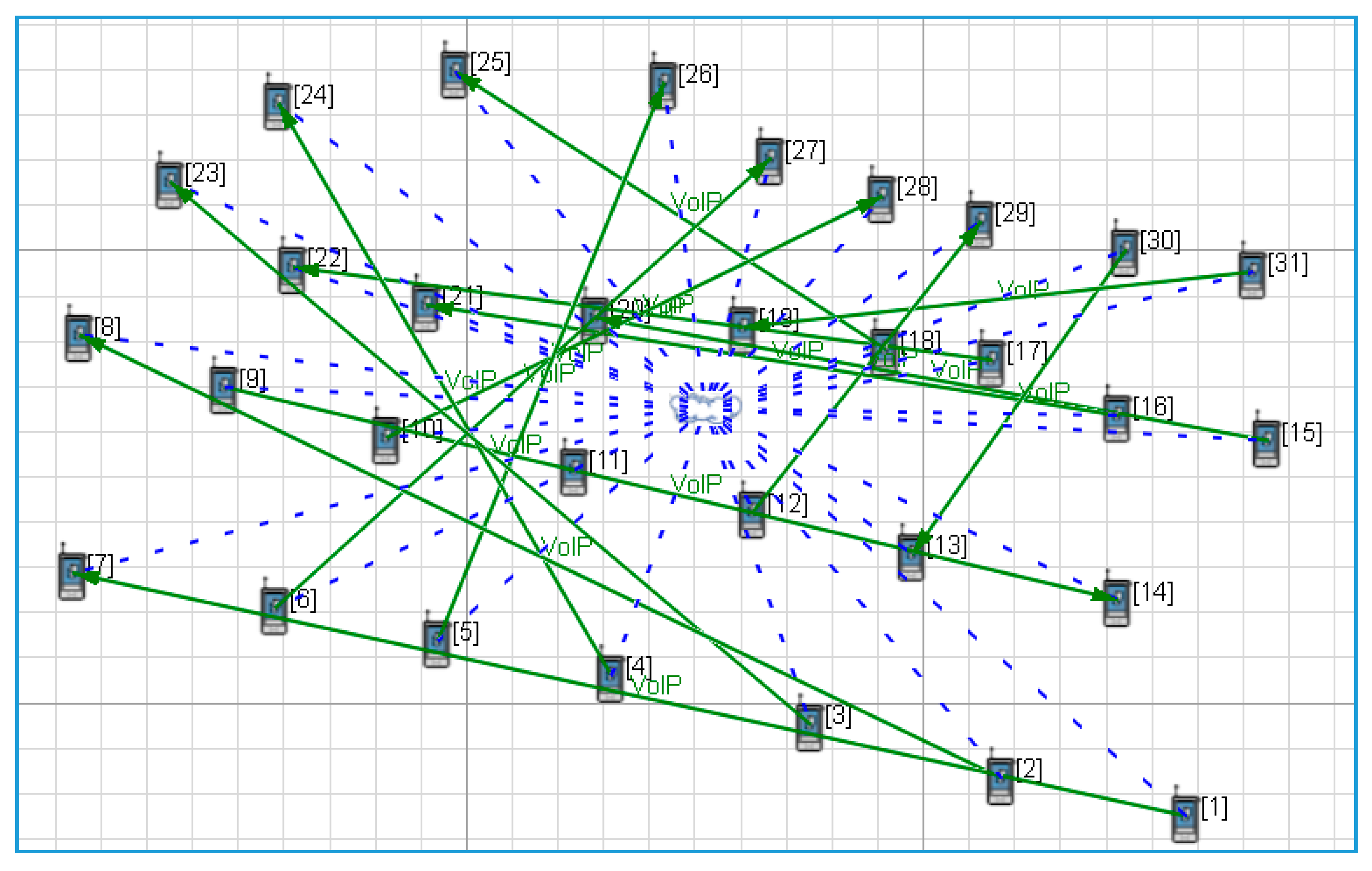
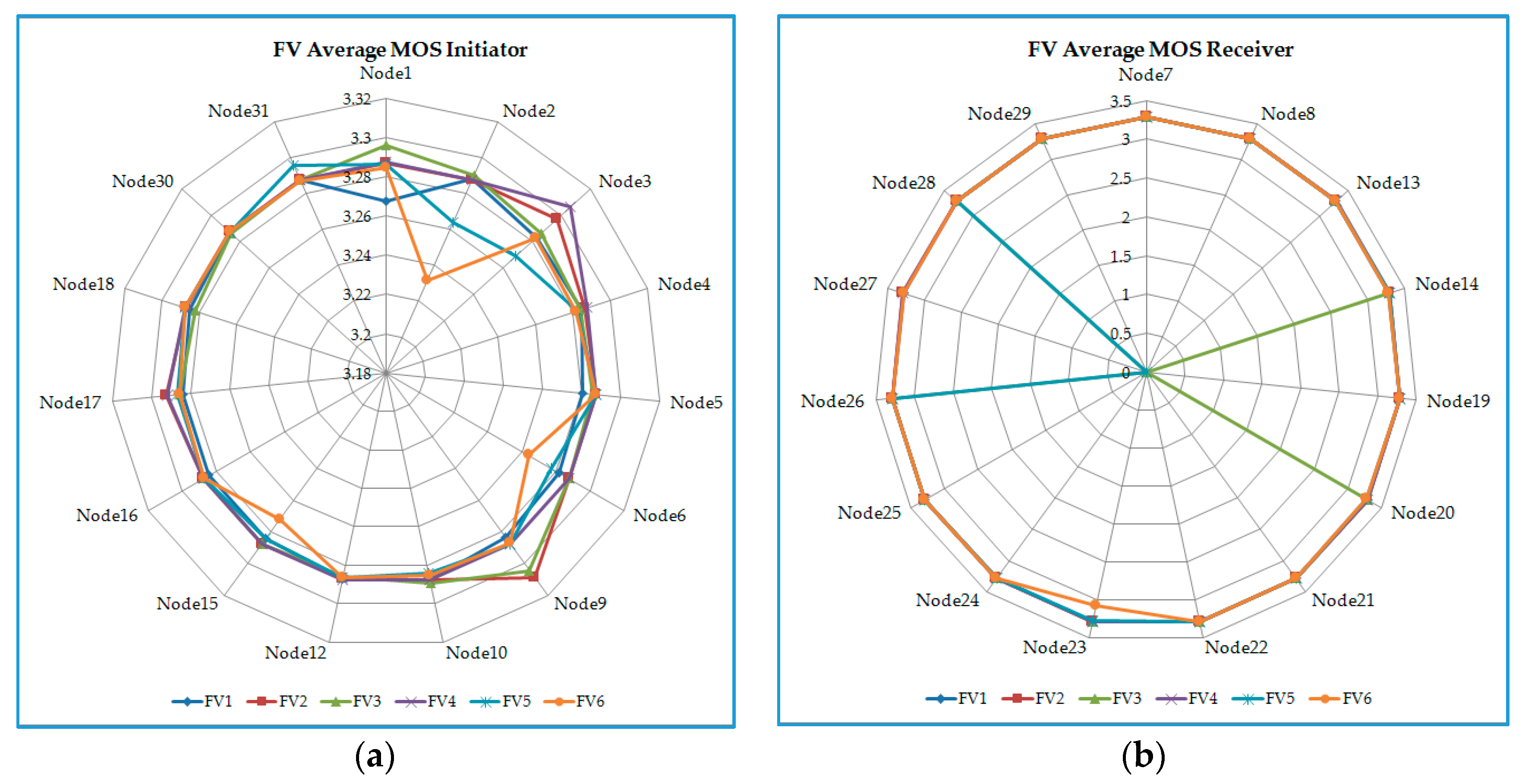
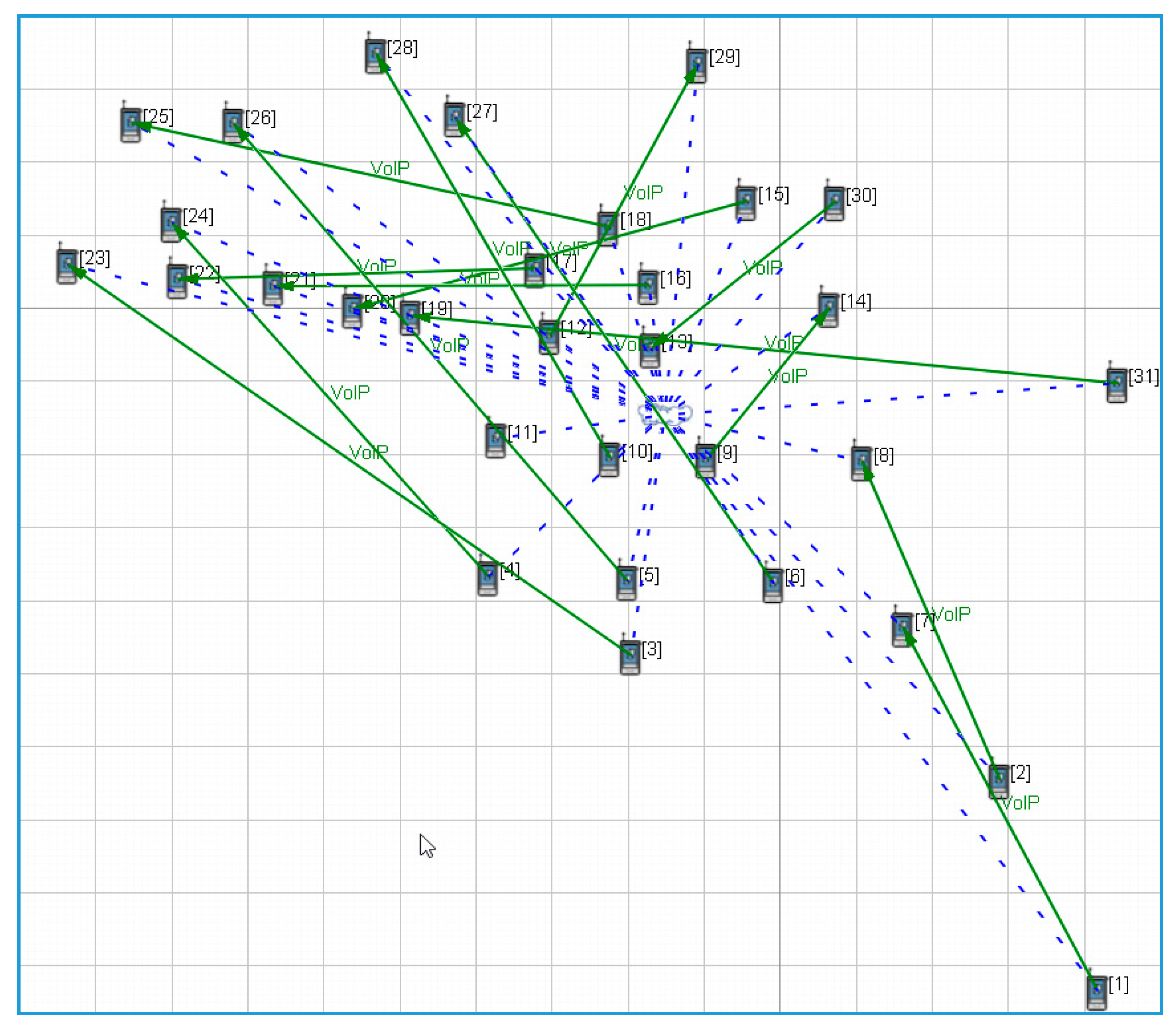
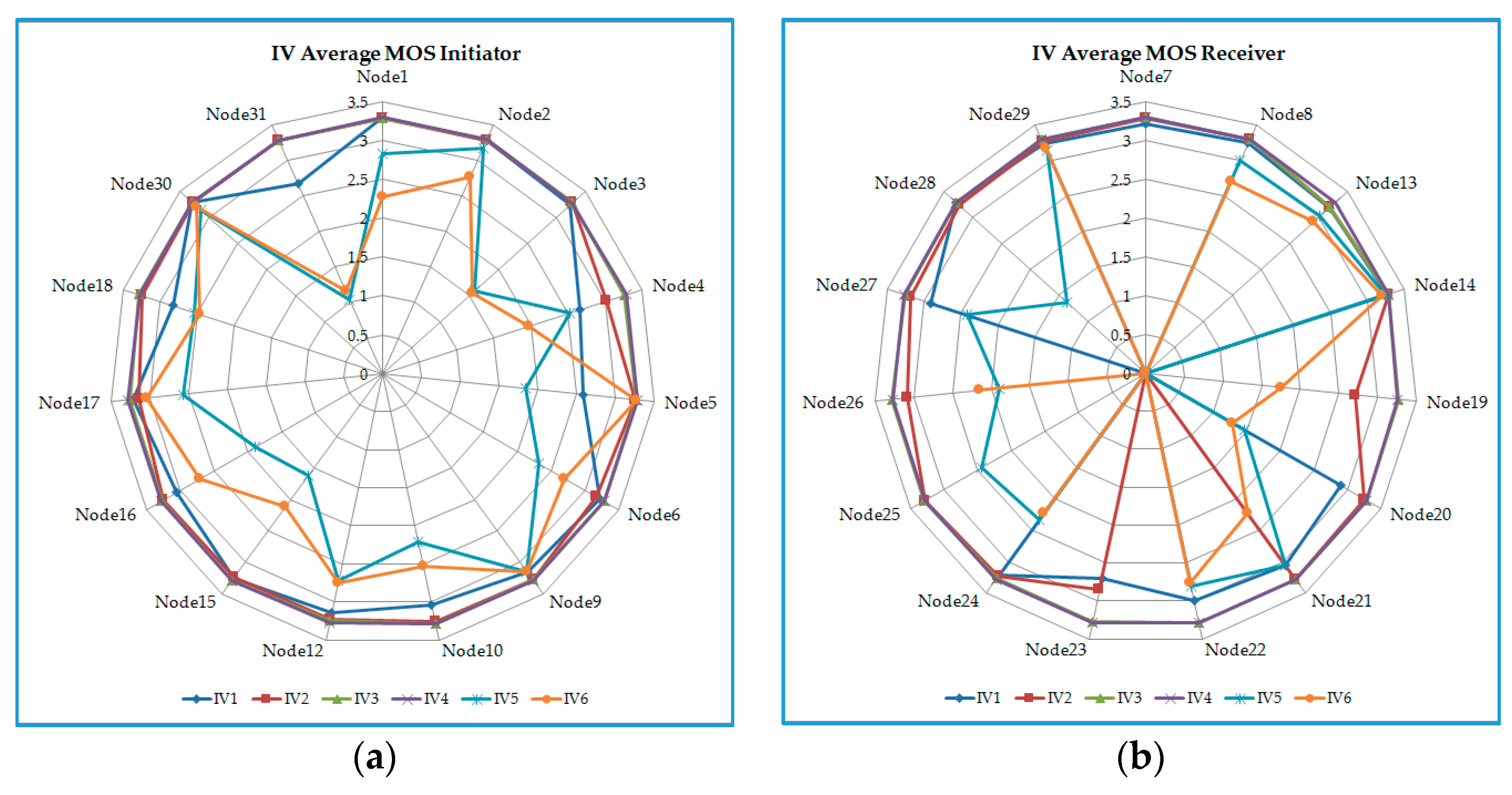
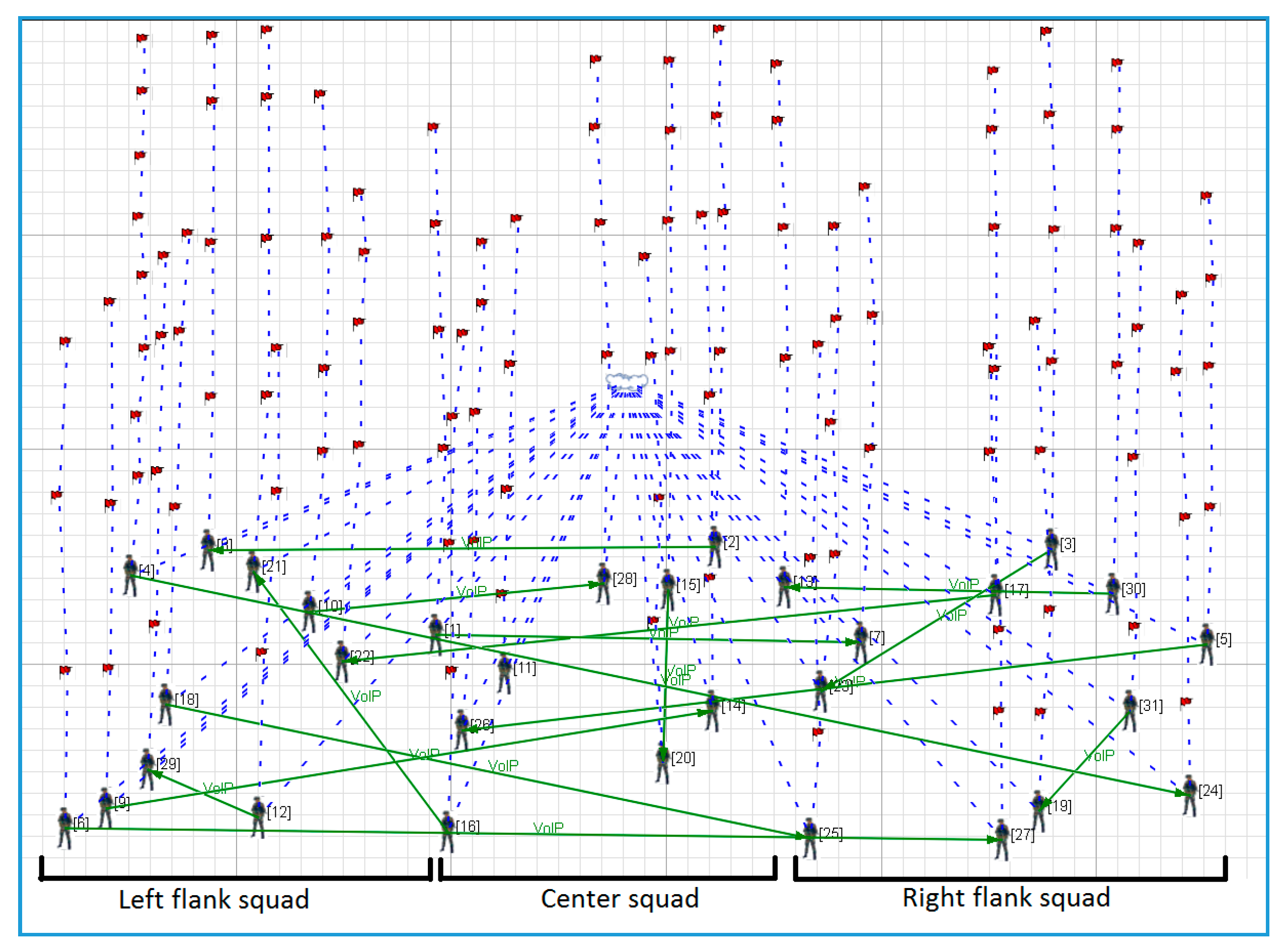
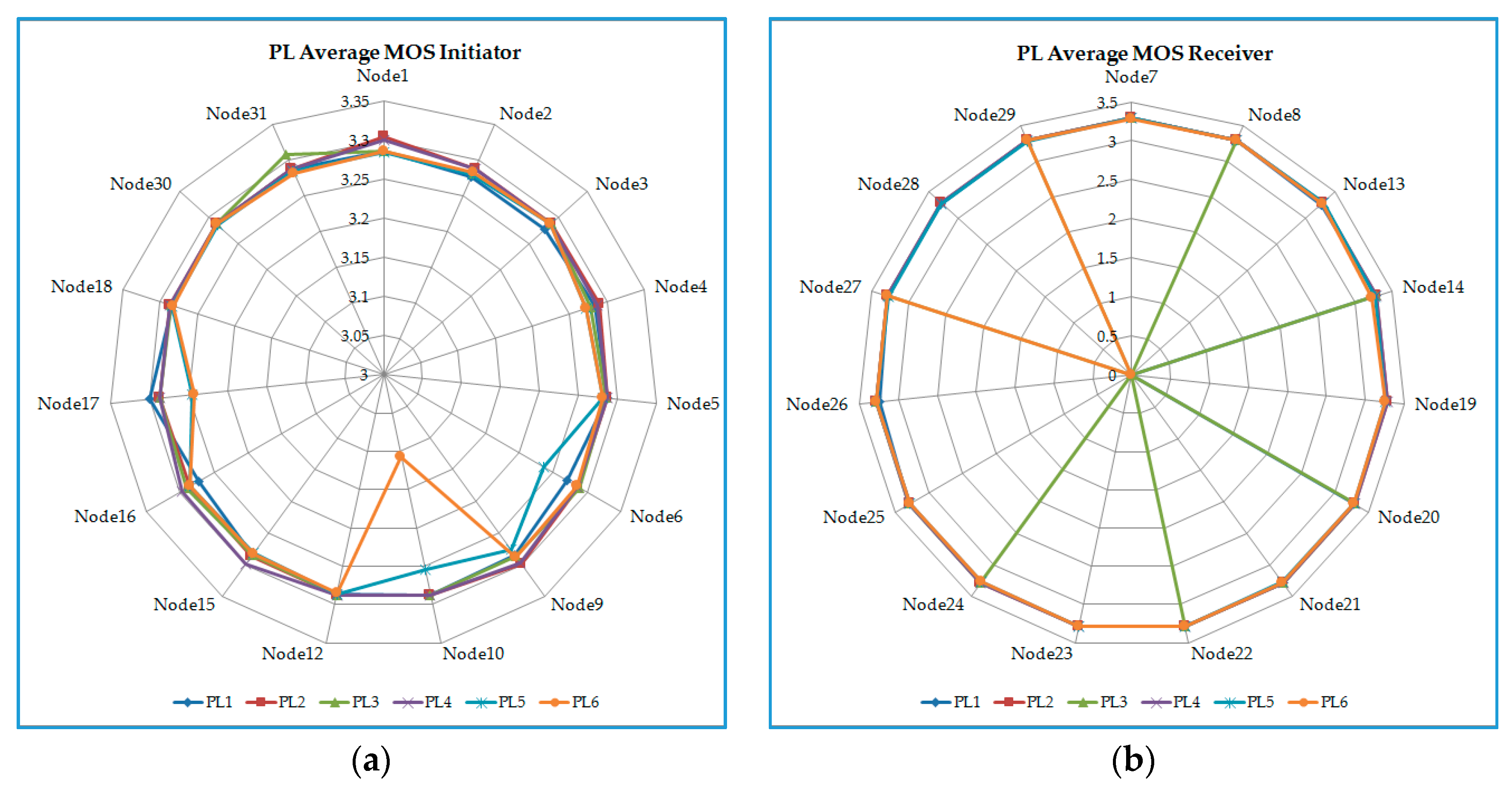
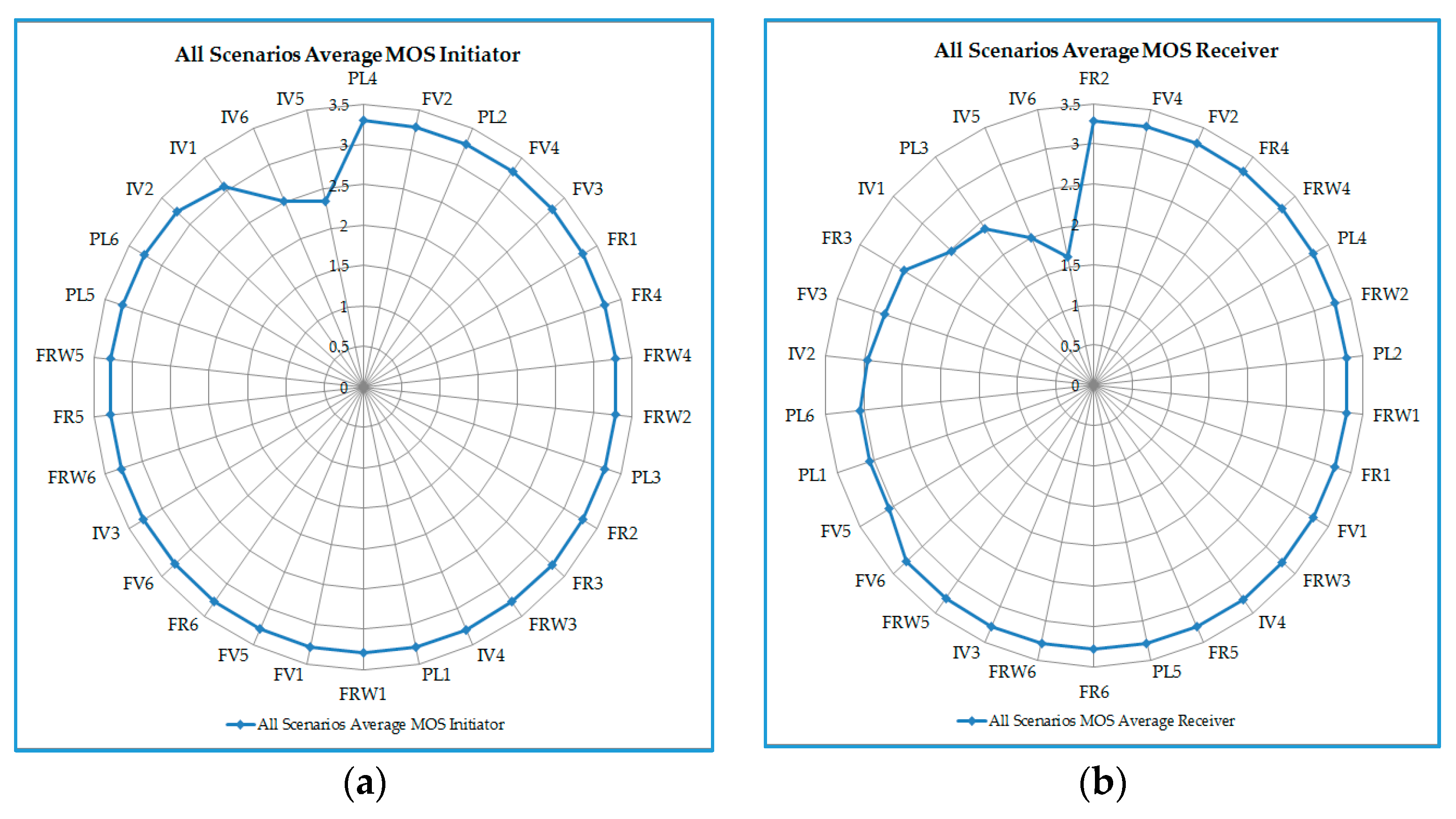
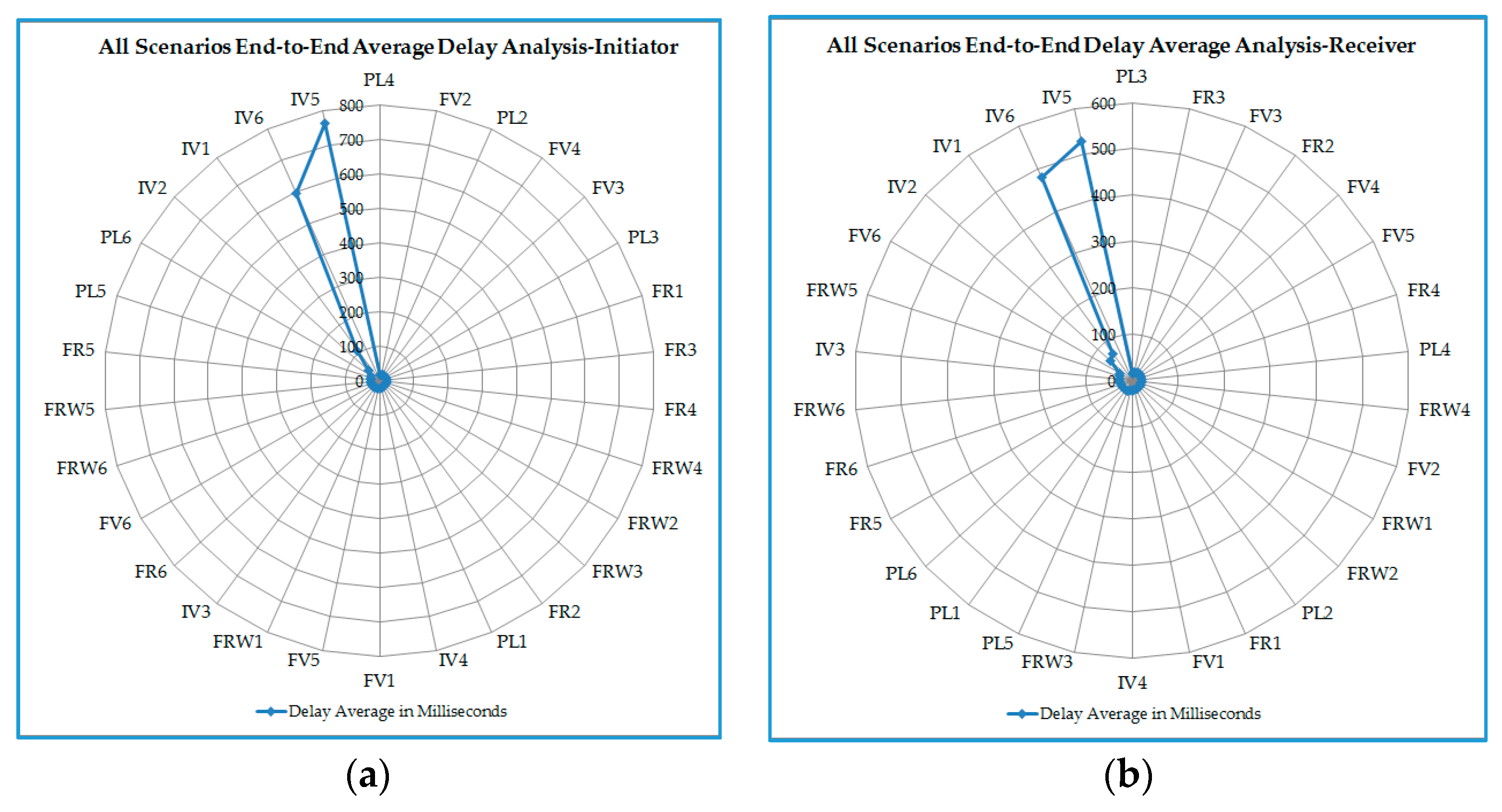
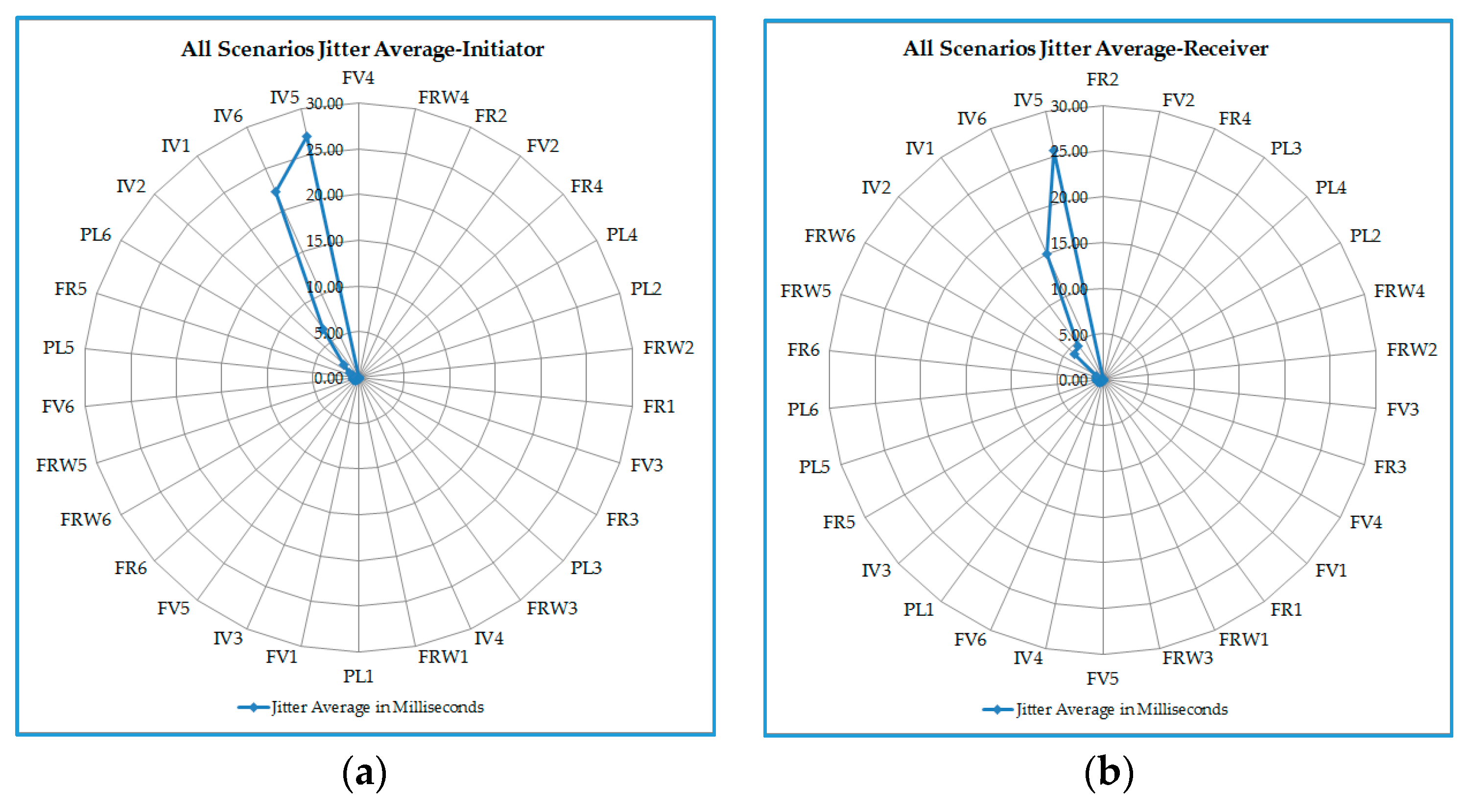
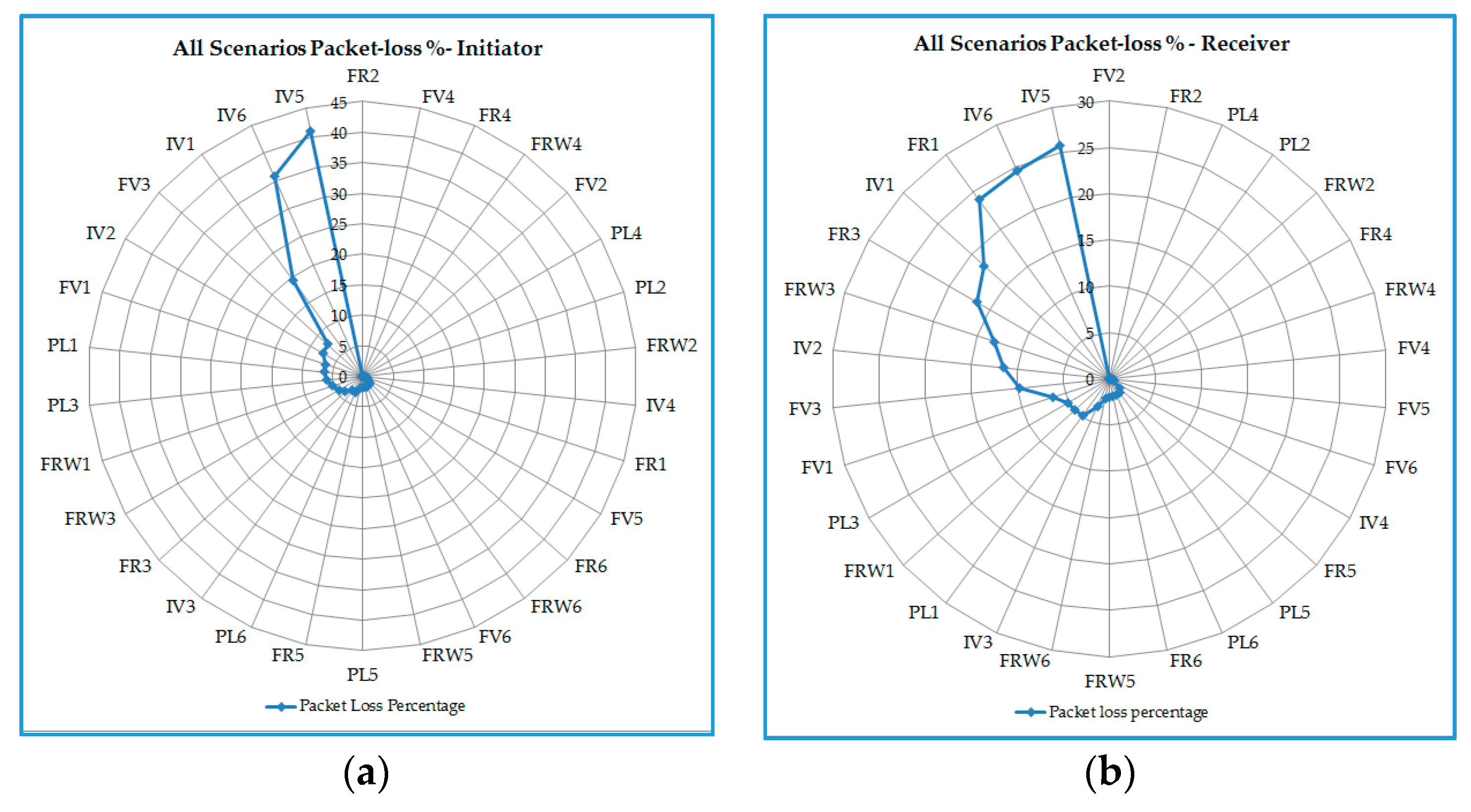
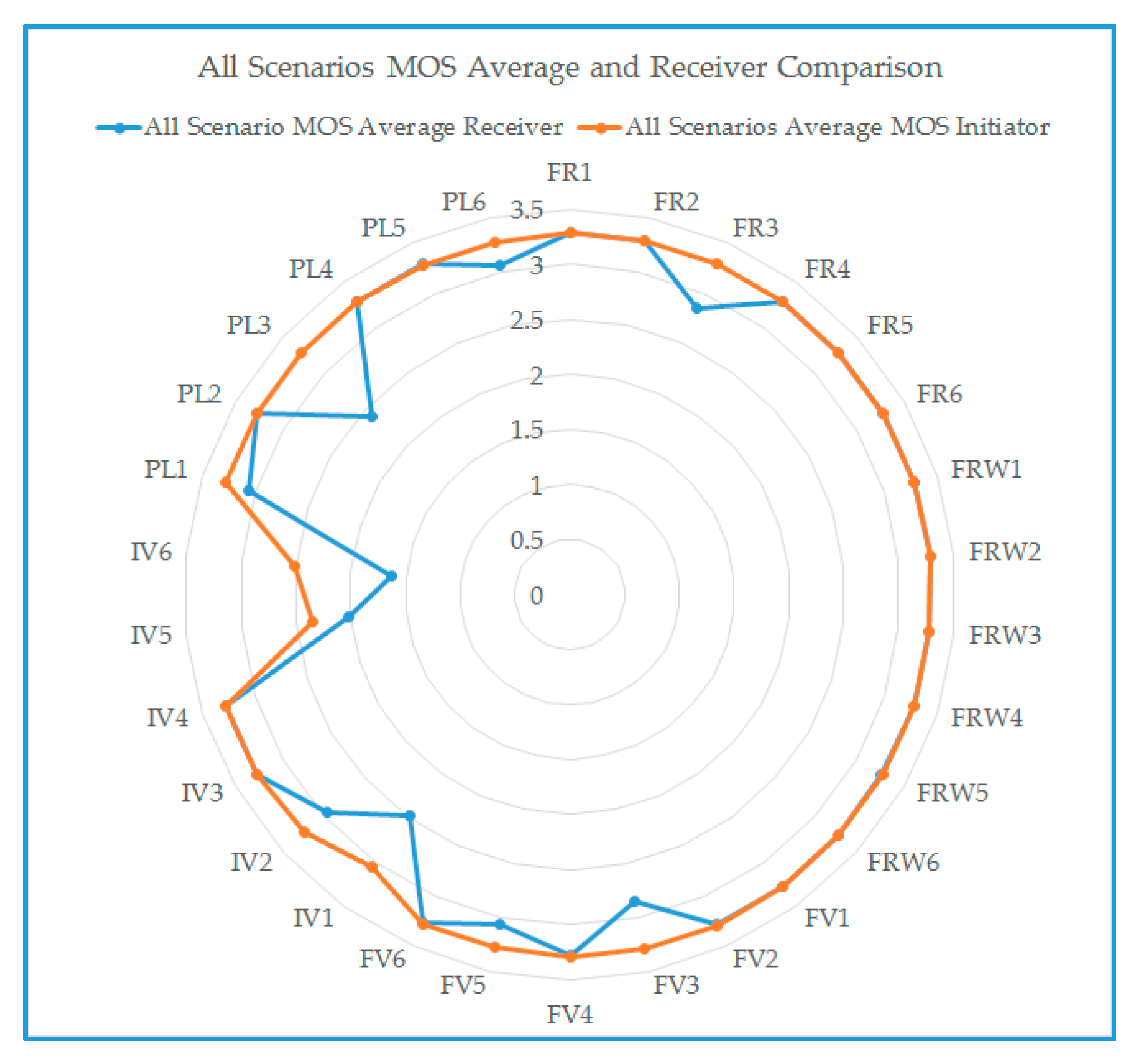
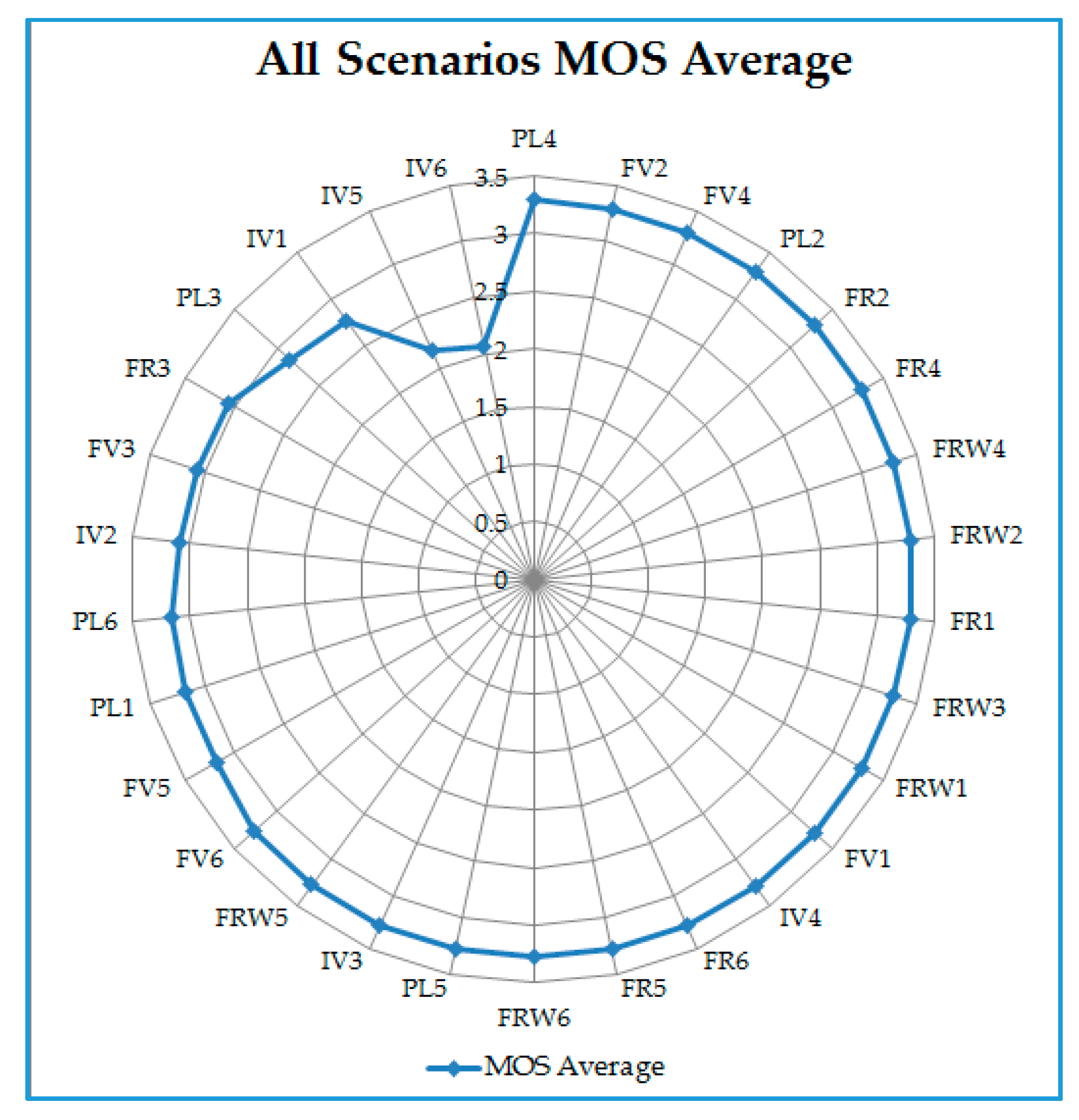
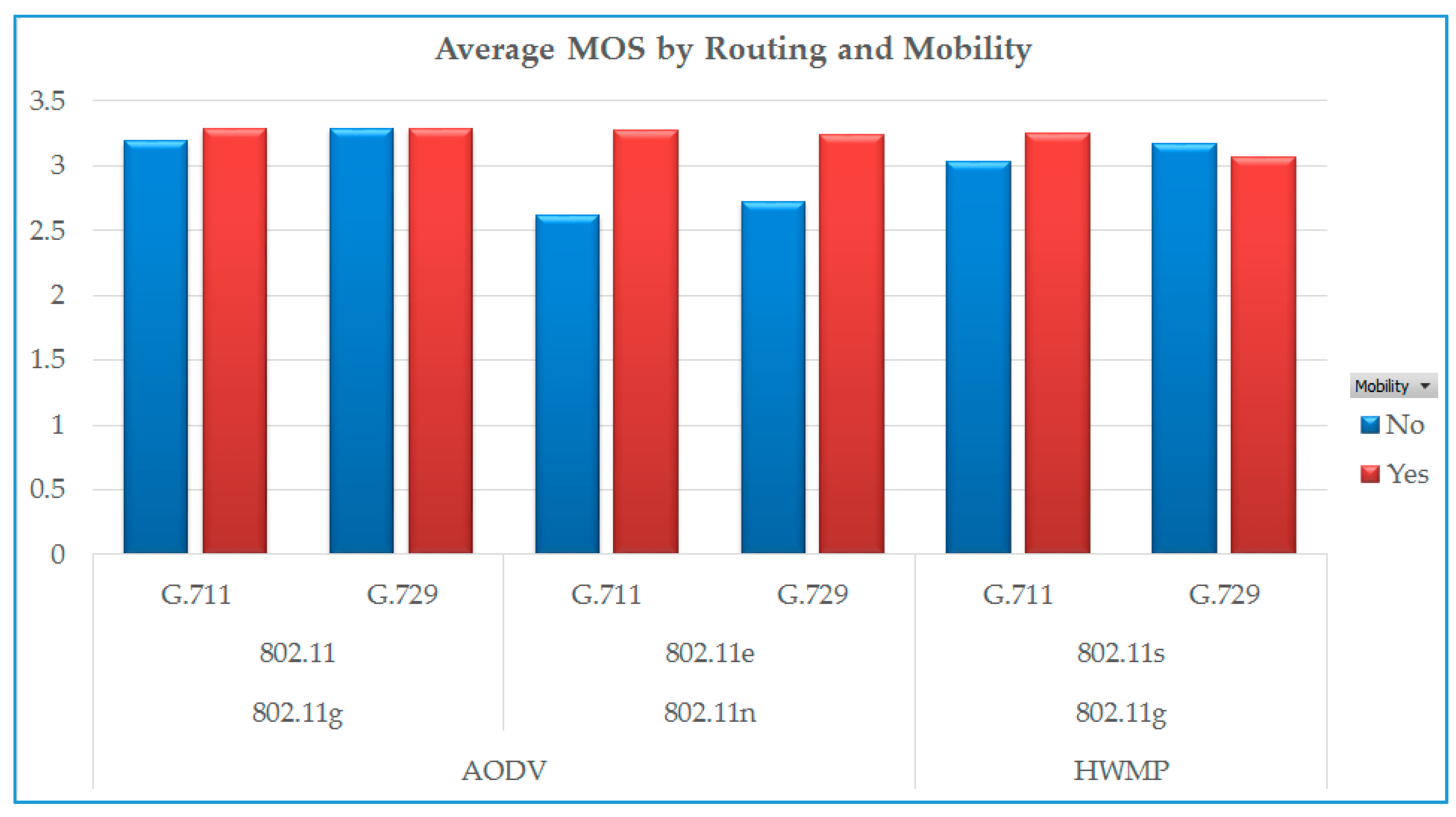
| Solution Name | Advantages | Limitations |
|---|---|---|
| IEEE 802.11s [1] | EDCA, differentiated service and access categories, own routing mechanism using HWMP | Not well supported and VoIP performance is not improved significantly |
| Admission Control QoS [29] | Channel reservation for multimedia traffic | Only solves the problem of access to the medium |
| Routing Protocols [30] | Better usage of resources with reactive routing and better performance with the proactive routing with the cost of using more resources | Reactive routing is slow, proactive routing is resource hungry. Slow routing results in excess delay and use of more resources consumes lots of device processing power and battery life |
| IEEE 802.11e [31] | EDCA function and good for infrastructure wireless network | Not developed for WMNs |
| Codec compression [32] | Choice of high quality codec can improve voice quality | Codec delay is only one small portion of the whole problem and high quality codec increases codec delay and generates large VoIP packets |
| Packet aggregation [30] | Avoids redundant packet headers, improves VoIP quality to some extent in special cases | Packetization and de-packetization delay is added. Takes more time to route large packets. Packetizing the packets travelling to different destinations is difficult in the relay nodes |
| Priority schedulers [33] | Improves VoIP performance to some extent | In case of a continuous flow, creates problem for low priority packets; does not work well for high loads |
| Load-aware mobility [10] | Load balancing of mesh nodes | Association phase gets delayed; does not perform well for high loads |
| Gateway placement [34] | Improves performance for a limited number of hops and if the nodes are communicating to external nodes | Does not solve the problem of mesh nodes communicating internally. |
| Traffic allocation for delay variation optimization (TADVO) [35] | Improves the delay factor using multiple paths and preferring paths with least amount of delay | This type of routing adds extra load. Puts route under continuous computation process |
| QoS Aware routing [36] | Prefers routes with least amount of load | Segmentation and use of several routing protocols adds to network complexity. May not work with high number of nodes due to multicasting function |
| Secure routing with QoS amplification SRQA [37] | Solves interference issues | Only addresses signal to noise ratio |
| Local packet recovery [38] | Recovering sporadic and link failure packet loss | Only addresses packet loss factor |
| Quality Level | MOS |
|---|---|
| Excellent | 4.3–5.0 |
| Very good | 4.0–4.3 |
| Good | 3.6–4.0 |
| Fair | 3.1–3.6 |
| Poor | 2.6–3.1 |
| Bad | 1.0–2.6 |
| Main Scenarios | Sub-Scenarios Description | Mobility/Speed | Short Name |
|---|---|---|---|
| First Responders | 802.11g, 802.11s, Mesh Points, G.711, HWMP | Waypoint | FR1 |
| 802.11g, 802.11, No Mesh Points, G.711, AODV | Waypoint | FR2 | |
| 802.11g, 802.11s, Mesh Points, G.729, HWMP | Waypoint | FR3 | |
| 802.11g, 802.11, No mesh Points, G.729, AODV | Waypoint | FR4 | |
| 802.11n, 802.11e, No Mesh Points, G.711, AODV | Waypoint | FR5 | |
| 802.11n, 802.11e, No mesh Points, G.729, AODV | Waypoint | FR6 | |
| First Responders-Random Waypoint | 802.11g, 802.11s, Mesh Points, G.711, HWMP | Random waypoint, 1.3 m/s | FRW1 |
| 802.11g, 802.11, No Mesh Points, G.711, AODV | Random waypoint, 1.3 m/s | FRW2 | |
| 802.11g, 802.11s, Mesh Points, G.729, HWMP | Random waypoint, 1.3 m/s | FRW3 | |
| 802.11g, 802.11, No mesh Points, G.729, AODV | Random waypoint, 1.3 m/s | FRW4 | |
| 802.11n, 802.11e, No Mesh Points, G.711, AODV | Random waypoint, 1.3 m/s | FRW5 | |
| 802.11n, 802.11e, No mesh Points, G.729, AODV | Random waypoint, 1.3 m/s | FRW6 | |
| Flooded Village | 802.11g, 802.11s, Mesh Points, G.711, HWMP | No | FV1 |
| 802.11g, 802.11, No Mesh Points, G.711, AODV | No | FV2 | |
| 802.11g, 802.11s, Mesh Points, G.729, HWMP | No | FV3 | |
| 802.11g, 802.11, No mesh Points, G.729, AODV | No | FV4 | |
| 802.11n, 802.11e, No Mesh Points, G.711, AODV | No | FV5 | |
| 802.11n, 802.11e, No mesh Points, G.729, AODV | No | FV6 | |
| Isolated Village | 802.11g, 802.11s, Mesh Points, G.711, HWMP | No | IV1 |
| 802.11g, 802.11, No Mesh Points, G.711, AODV | No | IV2 | |
| 802.11g, 802.11s, Mesh Points, G.729, HWMP | No | IV3 | |
| 802.11g, 802.11, No mesh Points, G.729, AODV | No | IV4 | |
| 802.11n, 802.11e, No Mesh Points, G.711, AODV | No | IV5 | |
| 802.11n, 802.11e, No mesh Points, G.729, AODV | No | IV6 | |
| Platoon | 802.11g, 802.11s, Mesh Points, G.711, HWMP | Waypoint | PL1 |
| 802.11g, 802.11, No Mesh Points, G.711, AODV | Waypoint | PL2 | |
| 802.11g, 802.11s, Mesh Points, G.729, HWMP | Waypoint | PL3 | |
| 802.11g, 802.11, No mesh Points, G.729, AODV | Waypoint | PL4 | |
| 802.11n, 802.11e, No Mesh Points, G.711, AODV | Waypoint | PL5 | |
| 802.11n, 802.11e, No mesh Points, G.729, AODV | Waypoint | PL6 |
| Parameters | Values | Remarks | |
|---|---|---|---|
| 802.11g | 802.11n | ||
| Phy-model | Phy802.11g | Phy802.11n | Common 802.11 standards |
| Transmit power (dBm) | 20 | 20 | Max transmit power for a node |
| Phy802.11-frequency-band | 2.4 | 2.4 | Used instead of 5 GHz, better coverage |
| Phy802.11-20MHz-channel-index | 6 | 6 | Operating channel |
| Parameters | Values | Remarks | ||
|---|---|---|---|---|
| 802.11 | 802.11e | 802.11s | ||
| MAC-PROTOCOL | MACDOT11 | 802.11e | MACDOT11 | |
| MAC-dot11-short-packet-transmit-limit | 7 | 7 | 7 | Default |
| MAC-dot11-long-packet-transmit-limit | 4 | 4 | 4 | Default |
| MAC-dot11-RTS-threshold | 0 | 0 | 0 | No limit |
| MAC-dot11-stop-receiving-after-header-mode | No | No | No | Default |
| MAC-dot11-association | None | None | Dynamic | Required for 802.11s |
| MAC-dot11-directional-antenna-mode | No | No | No | Not used |
| MAC-dot11-ssid | N/A | N/A | meeran | Required for 802.11s |
| MAC-dot11-ap | N/A | N/A | No | Not required |
| MAC-dot11-scan-type | N/A | N/A | Active | Required for 802.11s |
| MAC-dot11-sta-ps-mode-enable | N/A | N/A | No | Default |
| Dummy-MAC-dot11-set-mesh-parameters | N/A | N/A | Yes | Required for 802.11s |
| MAC-dot11s-mesh-id | N/A | N/A | meeran1 | Required for 802.11s |
| MAC-dot11s-path-protocol | N/A | N/A | HWMP | Required for 802.11s |
| MAC-dot11s-hwmp-active-route-timeout | N/A | N/A | 5 s | Default |
| MAC-dot11s-hwmp-my-route-timeout | N/A | N/A | 10 s | Default |
| MAC-dot11s-hwmp-reverse-route-timeout | N/A | N/A | 5 s | Default |
| MAC-dot11s-hwmp-route-discovery-type | N/A | N/A | Expanding-ring | Set for on demand mode |
| MAC-dot11s-path-metric | N/A | N/A | Airtime | Default metric for 802.11s |
| MAC-dot11s-link-setup-rate-limit | N/A | N/A | 1 | Default |
| MAC-dot11s-net-diameter | N/A | N/A | 7 | Default |
| MAC-dot11s-node-traversal-time | N/A | N/A | 100 ms | Default |
| MAC-dot11s-portal-timeout | N/A | N/A | 10 s | Default |
| MAC-dot11-directional-antenna-mode | N/A | N/A | No | Not required |
| Parameters | Values | Remarks |
|---|---|---|
| Network Diameter | 35 | Default |
| Node Traversal Time | 40 ms | Default |
| Active Route Timeout Interval | 3 s | Default |
| My Route Timeout Interval | 6 s | Default |
| Maximum RREQ Retries | 2 | Default |
| Route Deletion Constant | 5 | Default |
| Maximum Number of Buffered Packets | 100 | Default |
| Maximum Buffer Size | 0 | Default |
| TTL Start | 1 | Default |
| TTL Increment | 2 | Default |
| TTL Threshold | 7 | Default |
© 2017 by the authors. Licensee MDPI, Basel, Switzerland. This article is an open access article distributed under the terms and conditions of the Creative Commons Attribution (CC BY) license (http://creativecommons.org/licenses/by/4.0/).
Share and Cite
Meeran, M.T.; Annus, P.; Alam, M.M.; Moullec, Y.L. Evaluation of VoIP QoS Performance in Wireless Mesh Networks. Information 2017, 8, 88. https://doi.org/10.3390/info8030088
Meeran MT, Annus P, Alam MM, Moullec YL. Evaluation of VoIP QoS Performance in Wireless Mesh Networks. Information. 2017; 8(3):88. https://doi.org/10.3390/info8030088
Chicago/Turabian StyleMeeran, Mohammad Tariq, Paul Annus, Muhammad Mahtab Alam, and Yannick Le Moullec. 2017. "Evaluation of VoIP QoS Performance in Wireless Mesh Networks" Information 8, no. 3: 88. https://doi.org/10.3390/info8030088





